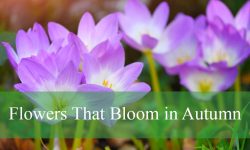Aloe plants are some of the most popular succulents, known for their unique forms and medicinal properties. Whether you’re a gardening enthusiast or someone looking to add an easy-care plant to your home, the types of aloe plants offer a variety of options to suit different preferences. With their striking rosettes, colorful blooms, and ability to thrive in dry conditions, aloes are a versatile choice for both indoor and outdoor spaces.
In this guide, we’ll explore 45 different types of aloe plants, each with its own distinctive features. From the small, compact varieties perfect for indoor containers to the towering tree aloes that make a dramatic statement in gardens, you’ll find a plant that fits your space and style. With clear identification tips and pictures, you’ll be able to easily recognize each type and determine which one is right for you.
Aloe plants are not only visually appealing but also offer benefits such as air purification and medicinal uses. Whether you’re growing aloes for aesthetic purposes, natural remedies, or as part of a sustainable garden, understanding the various types of aloe plants will help you make an informed decision.
Different Types of Aloe Plants
Bitter Aloe (Aloe ferox)
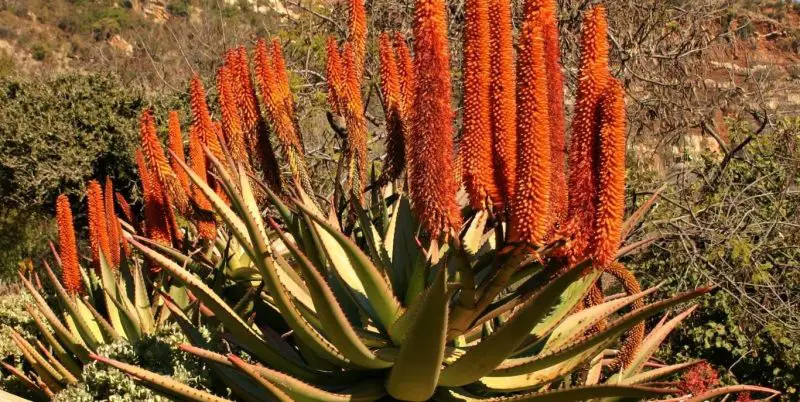
Bitter aloe is a large aloe species known for its striking appearance and brilliant flowers. The plant has thick, pale green leaves that are adorned with curved red barbs along the edges. The leaves can grow up to 3 feet in length, and they taper to a point. The plant produces multiple flower spikes that hold large clusters of deep orange flowers, which attract pollinators, such as bees and birds.
This aloe species thrives in full sun and requires minimal water, making it a perfect candidate for xeriscaping or drought-tolerant gardens. It grows best in loose, well-draining soil to avoid root rot. Bitter aloe is hardy in USDA zones 9-12, which accommodates a variety of climates, including warm and temperate regions. It can withstand brief periods of cold but should be protected from frost.
In addition to its ornamental beauty, bitter aloe has a long history of use in cosmetics and supplements. Its nectar-rich flowers attract pollinators, making it a valuable plant for supporting local wildlife. This highly adaptable species can be grown in gardens or containers, where it adds both beauty and practicality.
Red Aloe (Aloe cameronii)
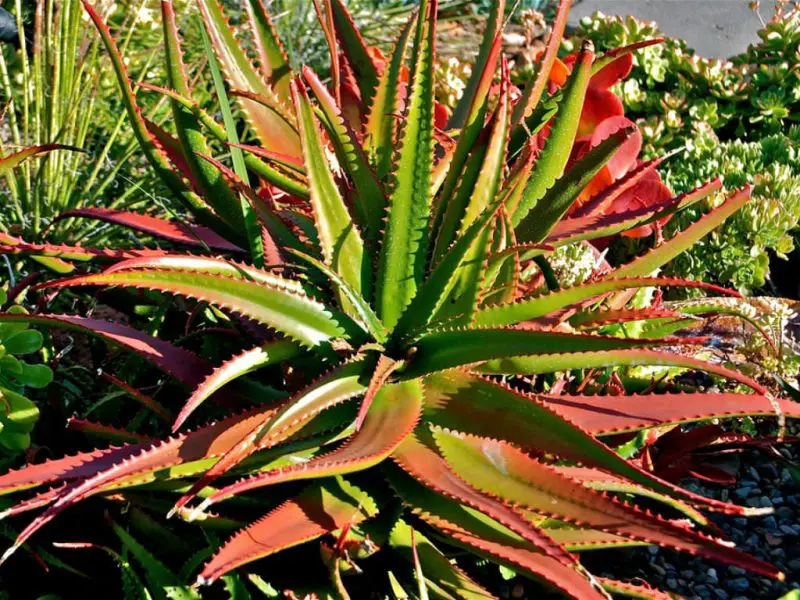
Red aloe is renowned for its striking and vibrant color, making it one of the most attractive aloe species. The plant forms loose rosettes of curving leaves, which are a beautiful gradient, starting with bright lime green at the center and transitioning to a rich rust color at the tips. The coloration varies depending on the amount of sunlight and water the plant receives, with more exposure to sun intensifying the red hues.
This aloe species grows to a height of 12-24 inches and has a mounding habit, making it a great addition to garden beds or containers. In the autumn, it sends up impressive flower spikes, each topped with a cone-shaped cluster of bright orange-red tubular flowers. These flowers are not only a visual treat but also attract pollinators like hummingbirds and bees.
Red aloe thrives in full sun and well-draining soil, and it is hardy in USDA zones 9-12. It requires low water, making it an excellent choice for drought-tolerant landscapes and xeriscaping projects.
Cape Speckled Aloe (Aloe microstigma)
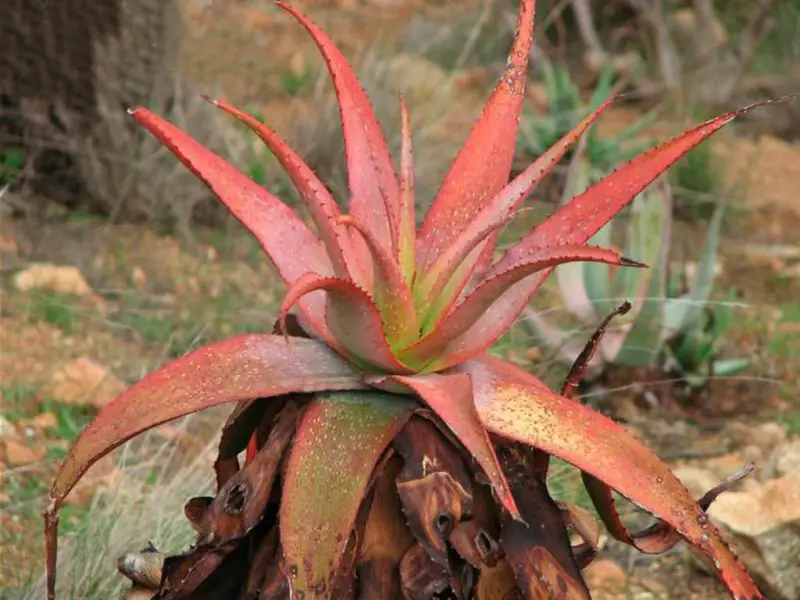
Cape speckled aloe is a medium-sized succulent with a distinctive rosette growth pattern. The leaves begin as chartreuse and develop a reddish hue as the plant matures or experiences environmental stress. These fleshy leaves are speckled with white spots and have red teeth along the edges, giving the plant a striking appearance. In spring, Cape speckled aloe produces several flower spikes, each topped with vibrant orange to yellow flowers that resemble torches, adding visual interest to the garden.
This aloe thrives in full sun and requires minimal water, making it suitable for low-maintenance gardens. It prefers loose, well-draining soil to avoid water accumulation. Hardy in USDA zones 9-11, it does well in warmer climates, where it can grow year-round without worrying about frost damage.
Cape speckled aloe is an excellent choice for adding color and texture to the garden. Its unique leaf coloration and the bright blooms make it a standout plant in both landscaped and container gardens. It’s a perfect addition for gardeners looking for a striking aloe that offers beauty for multiple seasons.
Carmine Aloe (Aloe ‘Carmine’)
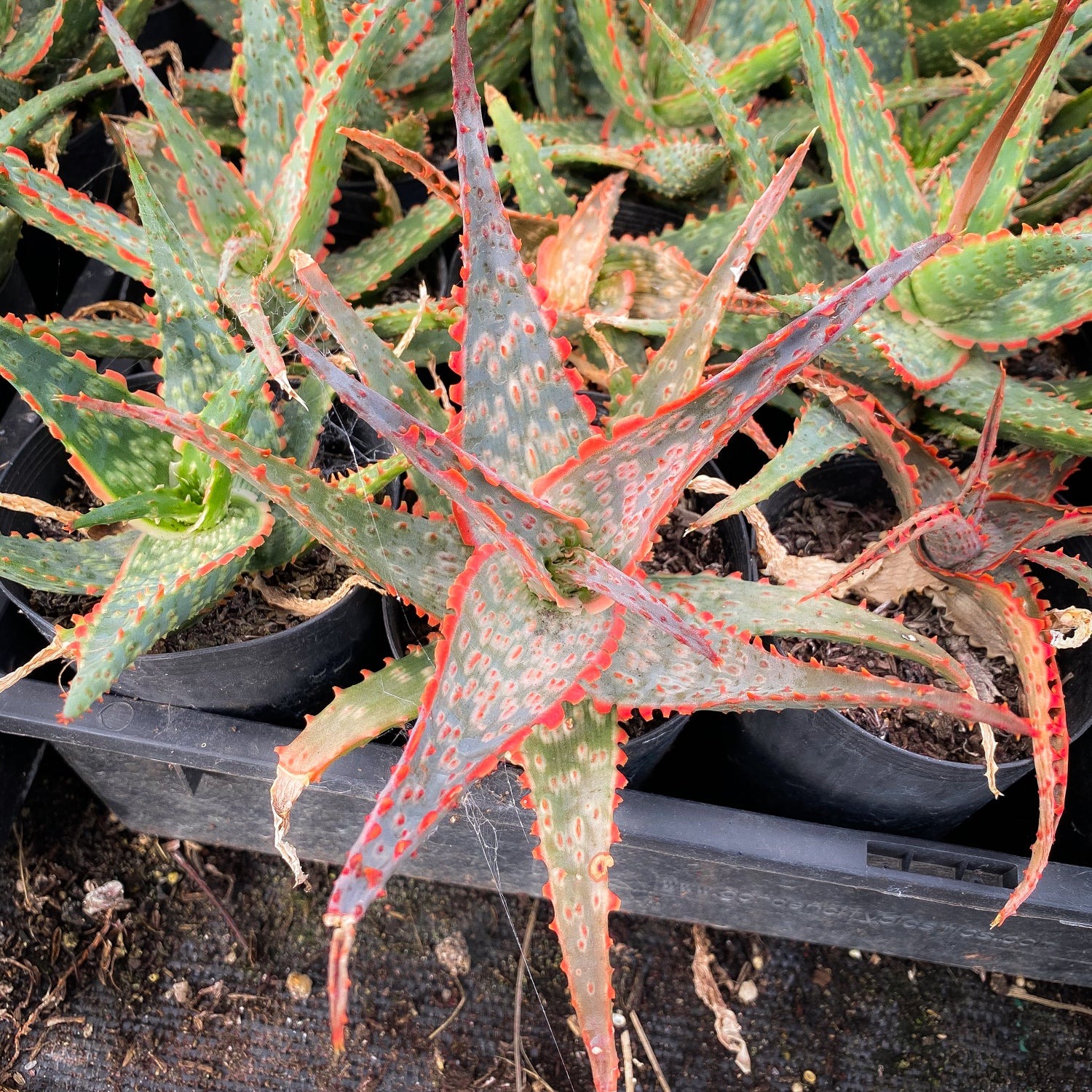
Carmine aloe is a small yet vibrant hybrid succulent with deep gray-green leaves that are deeply channeled and slightly curved. The leaves are spotted and have bright, almost neon-orange teeth along their edges, which gives the plant its unique look. While it rarely blooms, Carmine aloe may produce thin flower spikes topped with red blooms during the summer months.
This aloe species thrives in full sun to partial shade and requires minimal water, making it a perfect choice for drought-tolerant gardens. It prefers well-draining, loose soil to ensure the roots remain healthy. Carmine aloe is hardy in USDA zones 8-11, making it suitable for both indoor and outdoor cultivation in warmer climates.
Carmine aloe’s compact size and striking appearance make it a wonderful addition to smaller gardens or as a container plant. Its low water requirements and eye-catching color make it both a functional and ornamental choice for any garden.
Clanwilliam Aloe (Aloe comosa)
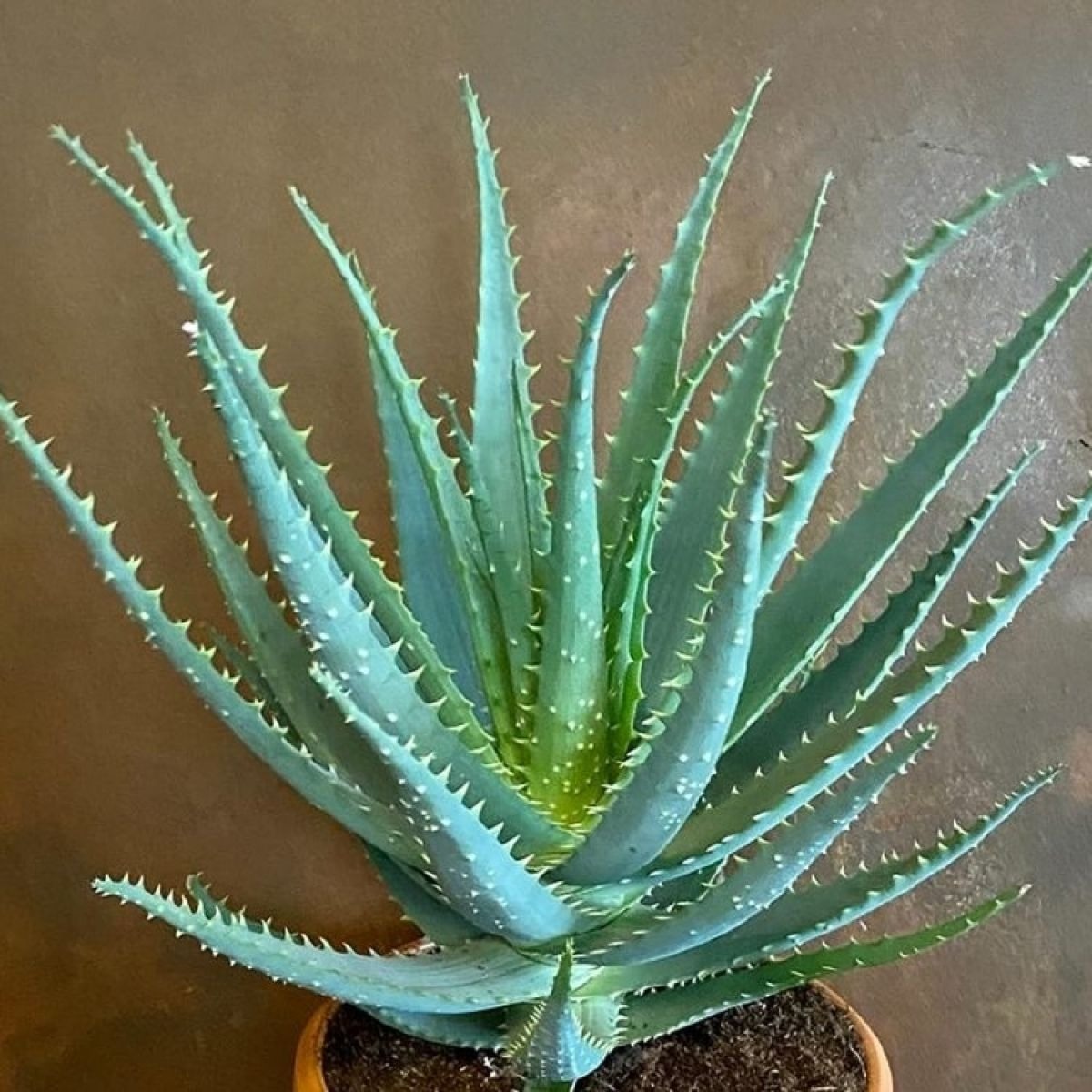
Clanwilliam aloe is a tree-like aloe species with a single central trunk that can grow up to 10 feet tall. The plant produces long, thick leaves that curve upward and can reach up to 2 feet in length. These leaves are lined with sharp brown-red teeth along the edges. Clanwilliam aloe is particularly notable for its striking pinkish ivory flowers that bloom on tall spikes, making it a beautiful feature in any garden.
This aloe thrives in full sun and prefers well-draining, loose soil, which helps prevent water retention around the roots. It has low water needs and is suitable for drought-tolerant landscapes. Hardy in USDA zones 9-11, Clanwilliam aloe is well-suited to warm climates and can be grown as a specimen plant or focal point in the garden.
The tree-like structure and impressive blooms of Clanwilliam aloe make it a standout addition to any garden. It is perfect for creating a dramatic vertical accent, especially in arid or semi-arid regions where it will thrive with minimal care.
Climbing Aloe (Aloiampelos ciliaris)
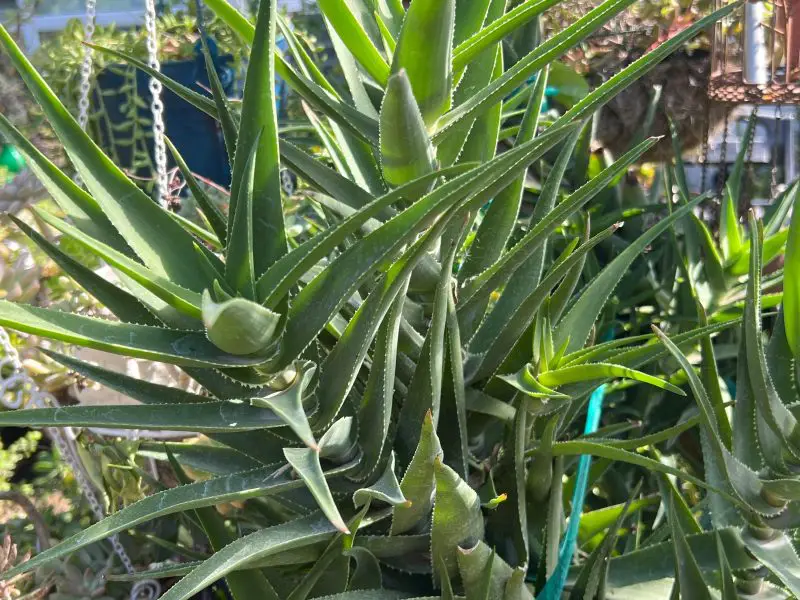
Climbing aloe is a fast-growing species that can reach heights of 30 feet or more, making it an excellent choice for vertical gardening or as a vine. This aloe produces striking orange-red tubular flowers that bloom year-round, although they are most common in spring. The flowers grow in tall, pointed clusters, making them highly attractive to pollinators. It can be grown both indoors and outdoors but needs to be placed next to a bright window if grown as a houseplant.
Climbing aloe thrives in full sun to part sun and requires minimal water. It prefers loose, well-draining soil to avoid root rot. Hardy in USDA zones 9-11, it is well-suited for gardens in warmer climates and can tolerate a bit more shade than most aloe species.
The rapid growth of Climbing aloe makes it ideal for creating a vertical garden or as a decorative vine. Its bright flowers and ability to bloom year-round provide color and interest, making it a great choice for gardeners looking to add vibrant, long-lasting beauty to their spaces.
Coral Aloe (Aloe striata)
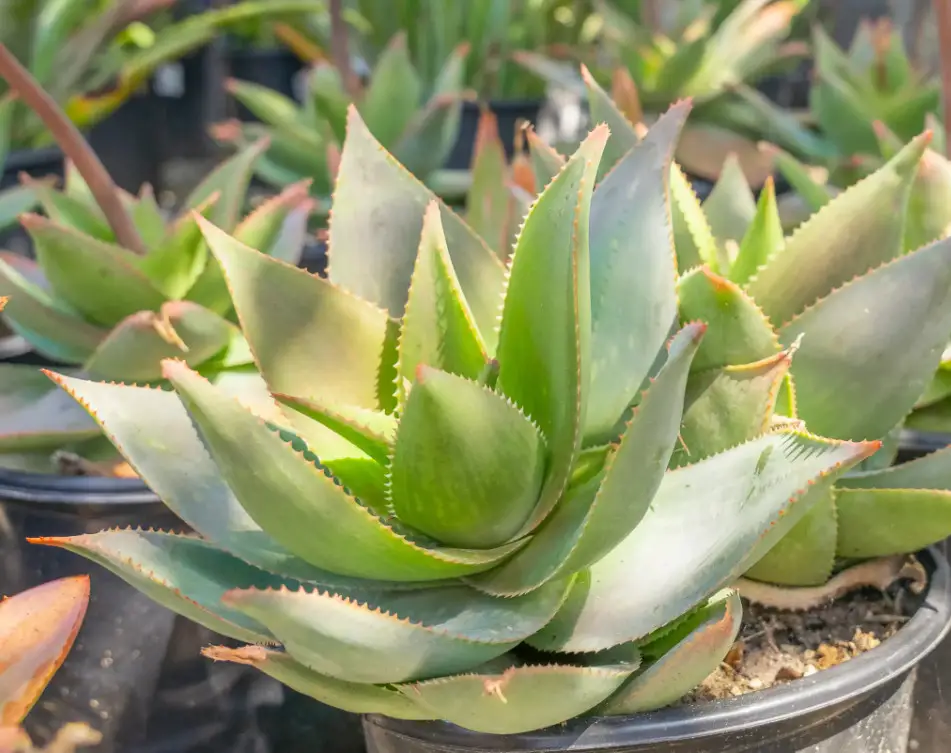
Coral aloe is a compact aloe species that grows to a height of 16-18 inches, making it perfect for smaller gardens or container planting. The plant features smooth, blue-green leaves that are edged with a coral-red color, which gives it its common name. In winter, Coral aloe sends up a tall branching flower spike, reaching about 3 feet, topped with coral-red, tubular flowers that hang downward in a graceful weeping fashion.
This aloe thrives in full sun and requires minimal water, making it well-suited to xeriscaping and low-maintenance gardens. It prefers loose, well-draining soil to prevent waterlogged roots. Hardy in USDA zones 9-11, it is ideal for warmer climates where it can grow year-round without the threat of frost.
Coral aloe’s colorful leaves and vibrant flowers make it an attractive addition to any garden, particularly in winter when many other plants are dormant. Its compact size and easy care requirements make it a popular choice for gardeners looking to add a touch of color and beauty to their landscapes.
Crosby’s Prolific Aloe (Aloe ‘Crosby’s Prolific’)
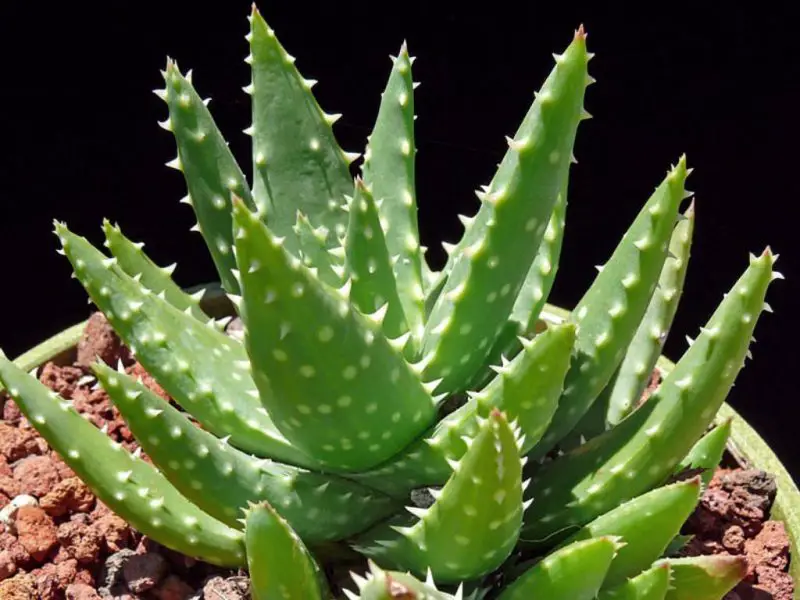
Crosby’s Prolific aloe is a compact, clumping hybrid that grows quickly to form dense mounds of vibrant green, speckled leaves. This miniature aloe species is an excellent choice for gardeners looking for a low-maintenance plant that thrives in full sun and poor soil. It’s also a prolific grower, spreading rapidly through offsets to create clusters of plants that can reach heights of 6-12 inches.
In spring, Crosby’s Prolific aloe produces striking orange-red, tubular flowers on 18-inch spikes. These bright blooms attract pollinators, especially hummingbirds, making it a perfect addition to a wildlife-friendly garden. With minimal water requirements and its adaptability to various soil types, this aloe is a great choice for xeriscaping or container gardening.
Hardy in USDA zones 9-11, Crosby’s Prolific aloe requires loose, well-draining soil to avoid water retention around the roots. Its spreading nature and vibrant blooms make it an excellent choice for adding color and texture to garden beds, patios, or even indoor spaces.
African Aloe (Aloe africana)
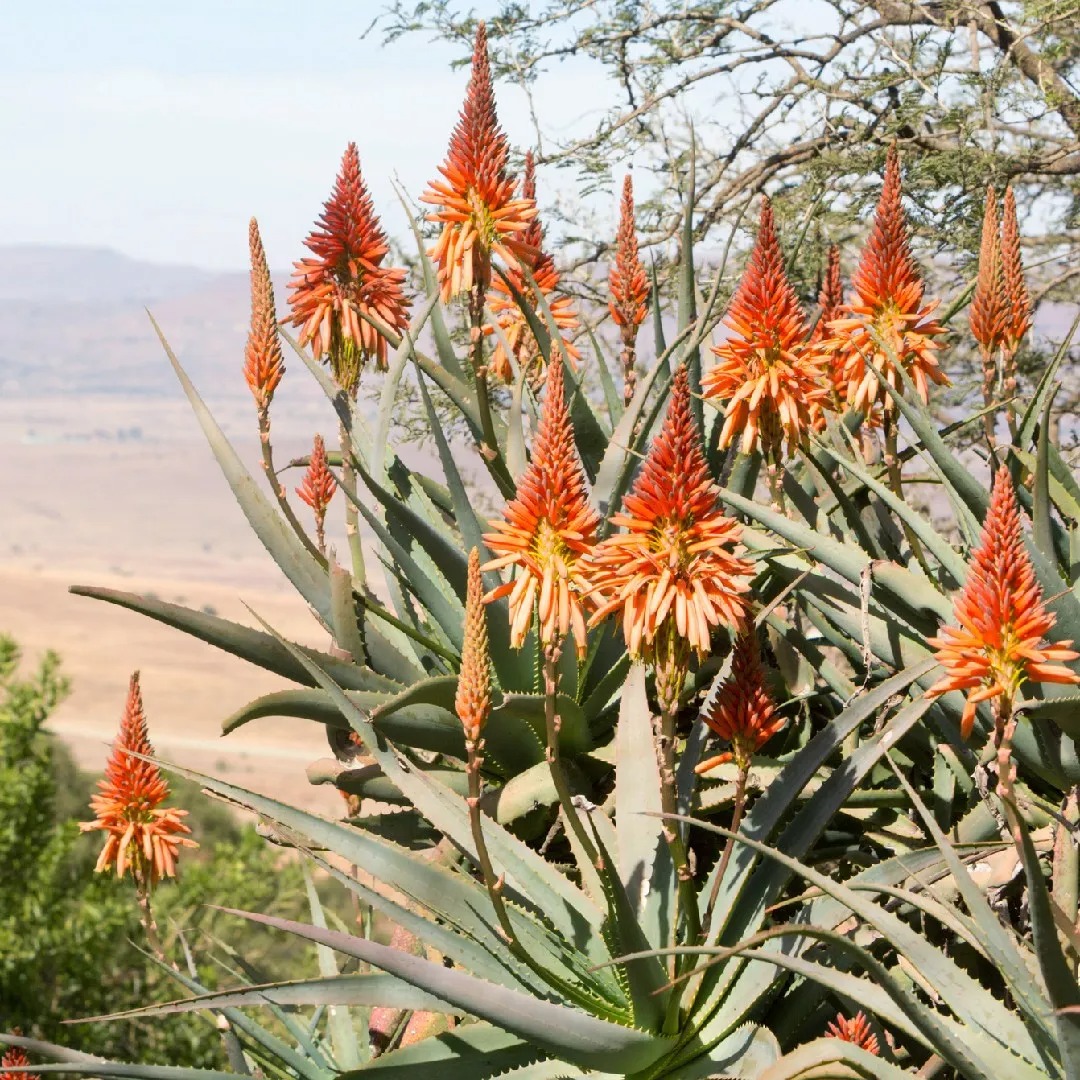
African aloe is a slow-growing, tree-like aloe that can reach heights of 6 to 8 feet. The plant’s leaves are somewhat disorganized, curving in different directions with edges that are tinged with red and lined with small, sharp teeth. This species takes about 4 to 5 years to mature and produce flowers, which bloom in large, multi-branched spikes with hundreds of bright orange, tubular-shaped flowers. The vibrant blooms turn up at the ends, adding to the plant’s striking appearance.
This aloe species thrives in full sun and requires minimal water, making it an excellent drought-tolerant plant. It does well in loose, well-draining soil, which helps prevent root rot. African aloe is hardy in USDA zones 9-11, which covers areas with warm temperatures year-round, such as parts of South Africa where the plant naturally grows.
Due to its tree-like form, African aloe is perfect for creating a unique landscape feature or adding height to a garden. It grows best in warmer climates and needs protection from frost in colder regions. Its dramatic flower spikes and attractive foliage make it a great addition to any garden in suitable growing zones.
Candelabra Aloe (Aloe arborescens)
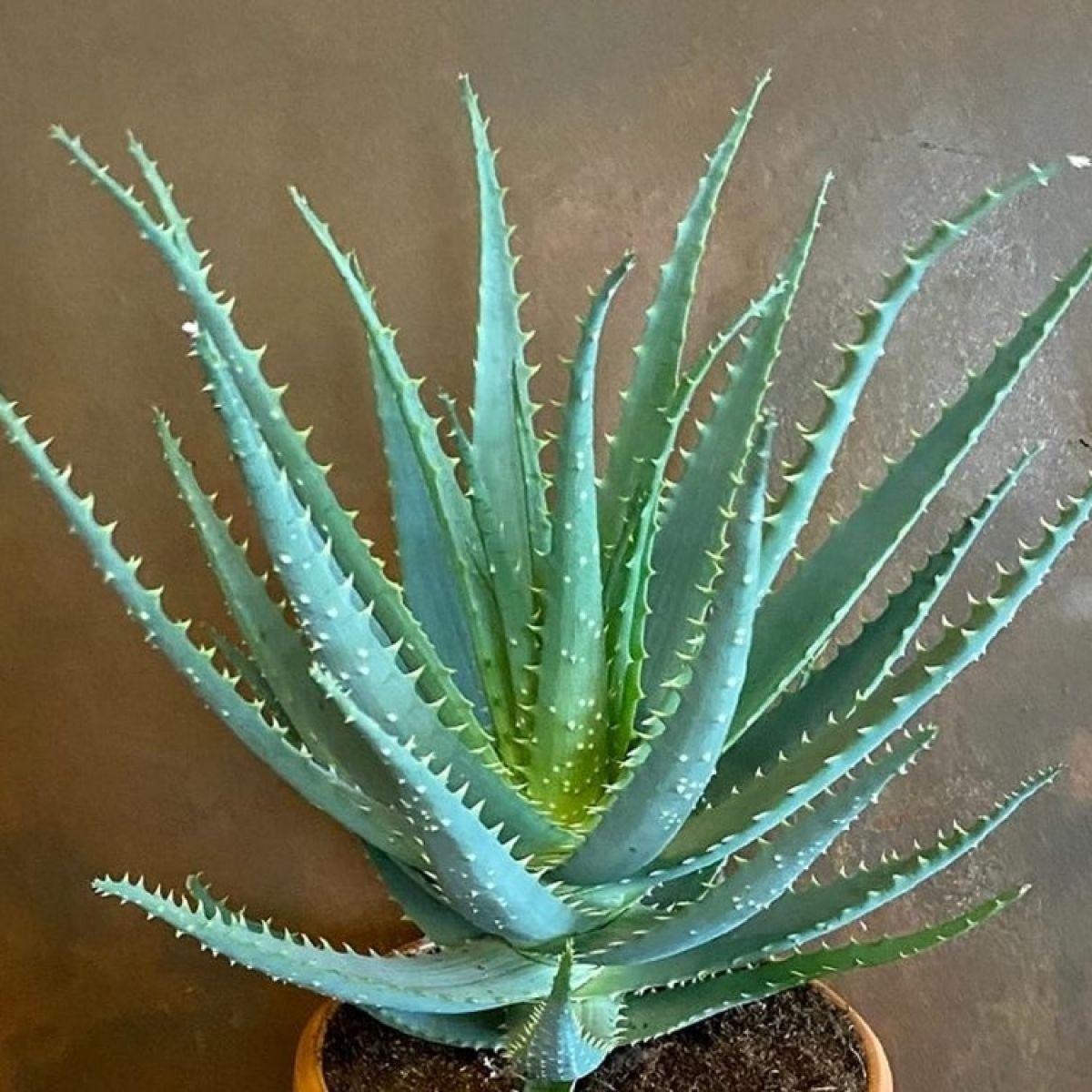
Candelabra aloe, also known as torch aloe, is a large aloe species that is often used as a hedge or border plant. It grows up to 10 feet in height and features thick, toothy leaves that grow in a branching, tree-like form. The leaves are tough and slightly curved, forming a rosette pattern at the plant’s base. This aloe blooms in the winter, with its tall flower spikes holding clusters of orange to yellow blooms, resembling a fiery torch, which is where the plant gets its nickname.
Candelabra aloe thrives in full sun and requires low water, making it ideal for xeriscaping or drought-tolerant gardens. It prefers well-draining, loose soil, which prevents water from accumulating at the roots. This species is hardy in USDA zones 9-11, where temperatures do not fall below freezing, and it can handle hot, dry conditions.
This aloe is also highly adaptable and can form a dense hedge if allowed to spread. It is particularly useful in outdoor gardens where it acts as a natural fence or barrier to keep animals out. Additionally, it’s an excellent choice for raised planters, where its bold appearance adds striking visual interest.
Aloe Vera (Aloe vera)
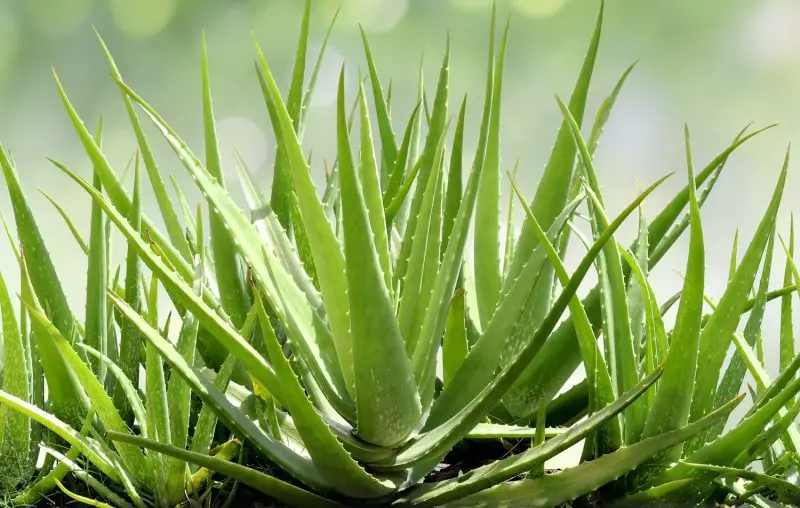
Aloe vera is one of the most common and widely known types of aloe, famous for its medicinal and cosmetic uses. This succulent grows to a height of 2 to 3.5 feet, with thick, fleshy green leaves arranged in a neat rosette. The leaves are long, thin, and arch downward, with a pointed tip. Aloe vera rarely blooms indoors but produces tall flower spikes topped with brilliant yellow flowers when grown outdoors in warm climates.
Aloe vera prefers full sun and low water requirements, thriving in well-draining, loose soil. It is a relatively low-maintenance plant, making it a popular choice for indoor gardening. Aloe vera is hardy in USDA zones 8-11, meaning it can tolerate temperatures as low as 20°F (-6°C) but is best suited to warmer climates.
The plant is widely recognized for its healing properties, especially in treating burns, cuts, and skin irritations. It is also used in digestive health products and cosmetics. Due to its versatility, aloe vera is commonly grown indoors as a houseplant, though it can be grown outdoors in regions with mild winters and ample sunlight.
Arabian Aloe (Aloe rubroviolacea)
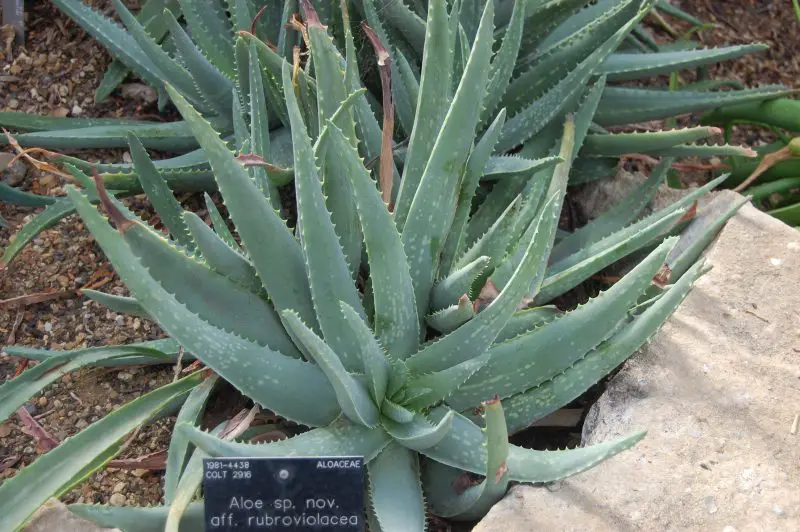
Arabian aloe is a stunning, ornamental aloe species native to the Arabian Peninsula. It features thick, fleshy leaves that are pale green when young and develop a reddish tinge in full sun. As the plant matures, its leaves turn a deeper red-violet in cooler temperatures. The leaves grow in an organized rosette, often sprawling sideways, which gives the plant a unique appearance, especially when viewed from above.
This aloe species blooms in winter, producing tall, unbranched spikes with large clusters of orange to red flowers. The showy blooms and colorful foliage make Arabian aloe a standout in gardens, and it thrives in full sun with low water needs. It requires loose, well-draining soil to prevent water from accumulating at the roots. Arabian aloe is hardy in USDA zones 9-11, where it can endure warm temperatures year-round and handle drought conditions.
Arabian aloe is an excellent choice for ornamental gardening, offering both vibrant color and unique form. It is particularly suited to warmer climates and can be grown in outdoor gardens or containers, making it a versatile addition to any landscape in the right growing zones.
Fan Aloe (Aloe plicatilis)
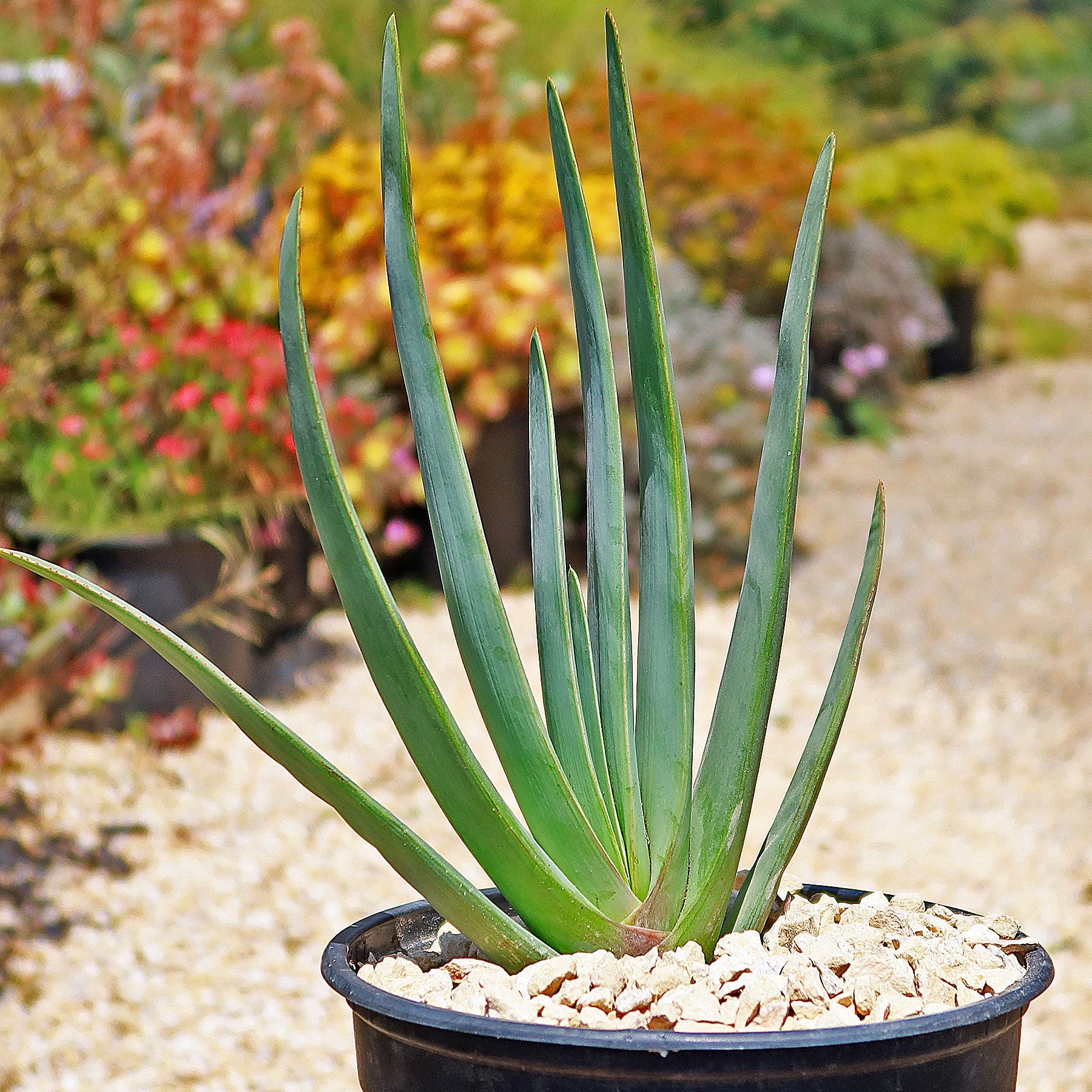
Fan aloe is a striking aloe species with a unique leaf arrangement that resembles a fan, giving the plant its common name. The long, flat, blue-green leaves curve inward toward the center of the fan, with coral-colored tips that add a touch of warmth. Unlike most aloes, the leaves of fan aloe fall off over time, exposing a smooth gray trunk and creating a tree-like appearance.
Reaching heights of 4-8 feet, fan aloe thrives in full sun and low-water conditions, making it a great fit for waterwise gardens. This aloe produces red-orange flowers in late winter, with each leaf fan producing its own flower spike. The blooms are eye-catching and add seasonal beauty to the landscape.
Fan aloe is hardy in USDA zones 9-12 and prefers well-draining soil. Its distinct fan-shaped foliage and showy red flowers make it a standout specimen plant, perfect for creating vertical interest or as a focal point in arid or Mediterranean-style gardens.
Gold Tooth Aloe (Aloe nobilis)
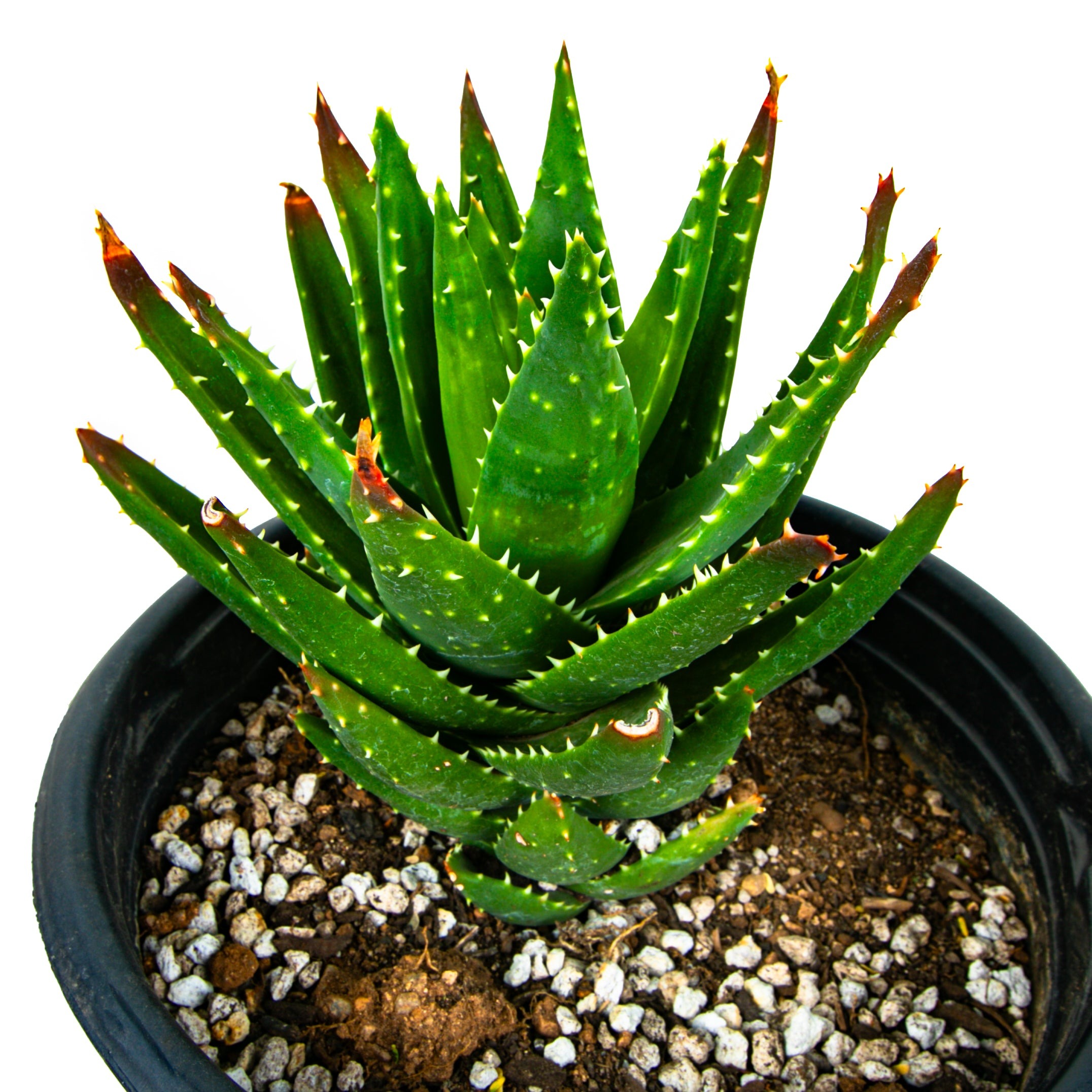
Gold tooth aloe is a compact aloe species known for its striking golden spines along the leaf margins, giving it its “gold tooth” name. This low-growing succulent forms clumps of rosettes that can reach heights of 6-12 inches. The plant is highly prolific and quickly sends out offsets, making it ideal for creating dense groupings or container plantings.
In spring, Gold Tooth aloe produces tall flower spikes with bright orange flowers that are attractive to pollinators like hummingbirds, bees, and butterflies. The plant’s ability to thrive in full sun and its low water requirements make it perfect for xeriscaping or gardens with poor soil conditions.
Gold Tooth aloe is hardy in USDA zones 9-11 and thrives in loose, well-draining soil. Its compact size and attractive flowers make it an excellent choice for containers, raised beds, or as a decorative groundcover in drought-tolerant gardens.
Haworthia-leaved Aloe (Aloe haworthioides)
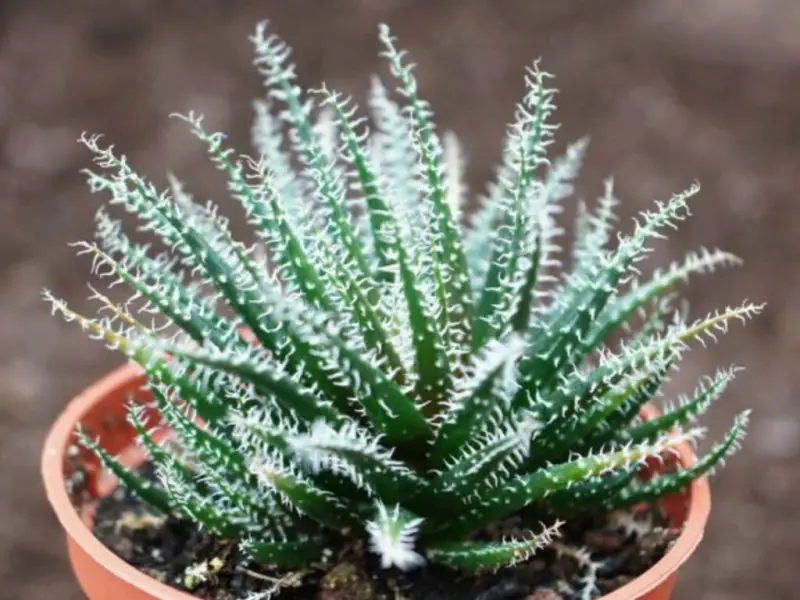
Haworthia-leaved aloe is a small, fast-growing aloe species that is often confused with haworthia, although it belongs to the Aloe genus. This compact plant features tightly packed rosettes of dark green leaves that are covered in white spots and fine, hair-like structures, giving the leaves a fuzzy appearance. Despite its small size, this aloe species offers year-round interest with its unique foliage and inconspicuous flower spikes.
Growing to a height of just 3-4 inches, Haworthia-leaved aloe thrives in full sun and requires low water, making it an excellent choice for drought-tolerant gardens. The small flower spikes, which appear in summer and can last into fall, add a subtle touch of beauty to the plant without overpowering its overall appearance.
Hardy in USDA zones 9-11, Haworthia-leaved aloe is ideal for rock gardens, container gardens, or as a groundcover in arid climates. Its distinctive, fuzzy leaves and low-maintenance care requirements make it a fantastic addition to waterwise landscapes.
Jemen Aloe (Aloe squarrosa)
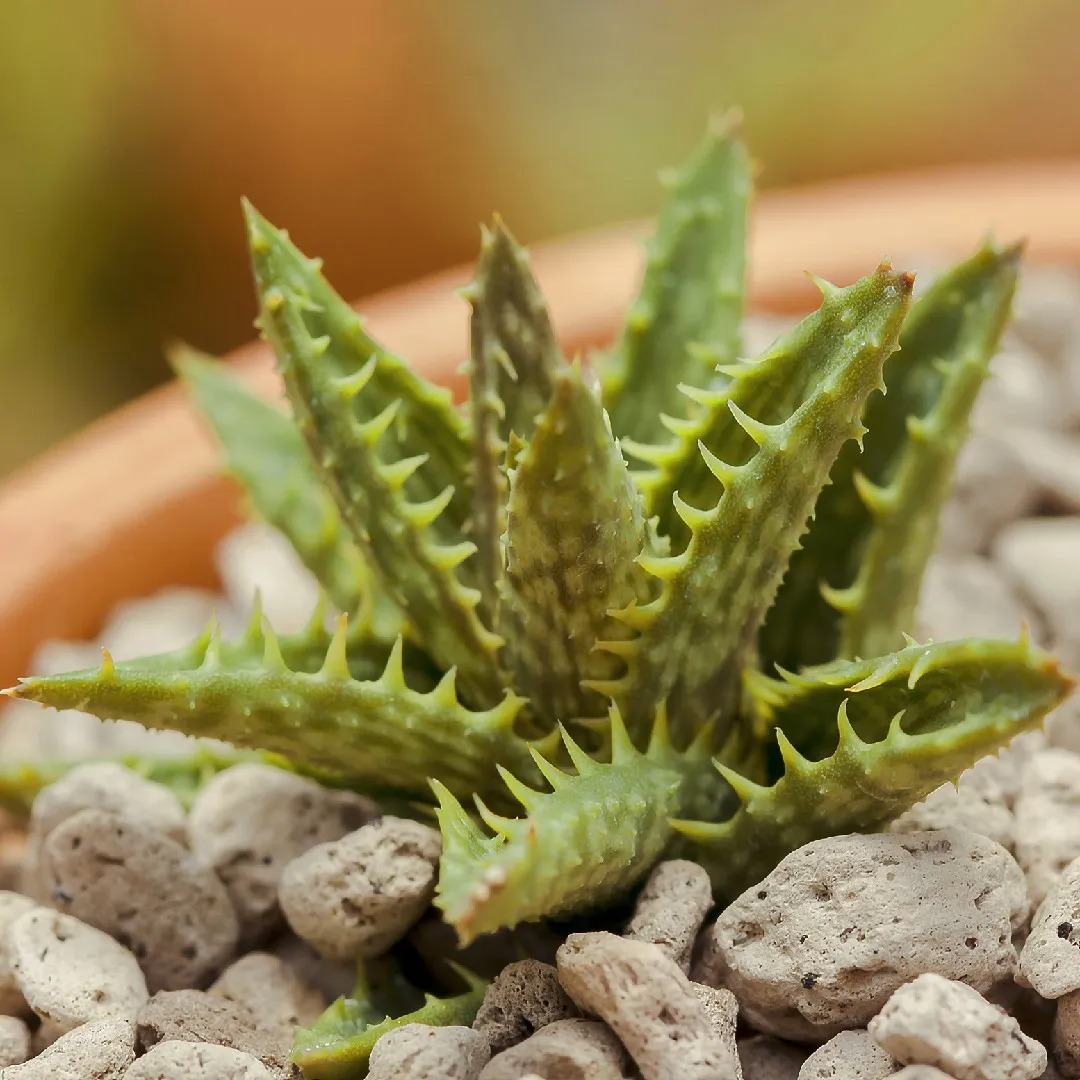
Jemen aloe, native to the island of Socotra in Yemen, is a unique species that shares similarities with Tiger Tooth aloe (Aloe juvenna). This drought-tolerant succulent is known for its thick, bright green leaves that are often spotted and curve outward. The leaves are bordered with white, spiky teeth, adding texture and visual interest to the plant.
Reaching a height of 35-36 inches, Jemen aloe is a relatively short species that can be grown in a variety of climates. It goes dormant in the winter and becomes active during the spring and summer months, making it a low-maintenance choice for gardeners. The plant’s coral-red flowers bloom in the spring and add a vibrant pop of color to the landscape.
Jemen aloe is hardy in USDA zones 9-11 and thrives in well-draining soil with minimal water requirements. Its heat tolerance and ability to thrive in poor soils make it an excellent candidate for xeriscaping or as a striking accent plant in dry landscapes. Its unique texture and vibrant flowers make it a beautiful addition to any garden.
Lace Aloe (Aloe aristata)
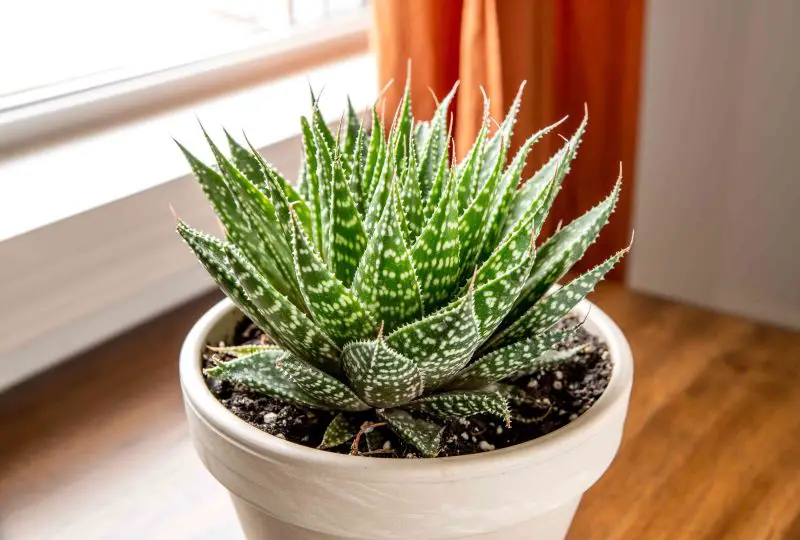
Lace aloe is a small, striking succulent with deep green leaves that are covered in white speckles, giving the plant a lace-like appearance. This species is frost-hardy, which is a rare trait for aloes, making it an excellent choice for gardeners in cooler climates. Growing to a height of 8-12 inches, lace aloe forms compact rosettes that are ideal for containers, rock gardens, or as an accent plant in mixed succulent displays.
Lace aloe produces delicate pink flowers late in the summer, which attract hummingbirds and bees. The flowers, combined with the plant’s unique texture, make it a captivating addition to any garden. This aloe thrives in full sun and low-water conditions, making it a great candidate for drought-tolerant landscaping.
Hardy in USDA zones 8-12, lace aloe requires loose, well-draining soil to ensure proper drainage and avoid root rot. It’s a versatile and low-maintenance plant that provides visual interest year-round, especially in xeriscaped gardens.
Malagasy Tree Aloe (Aloe vaombe)
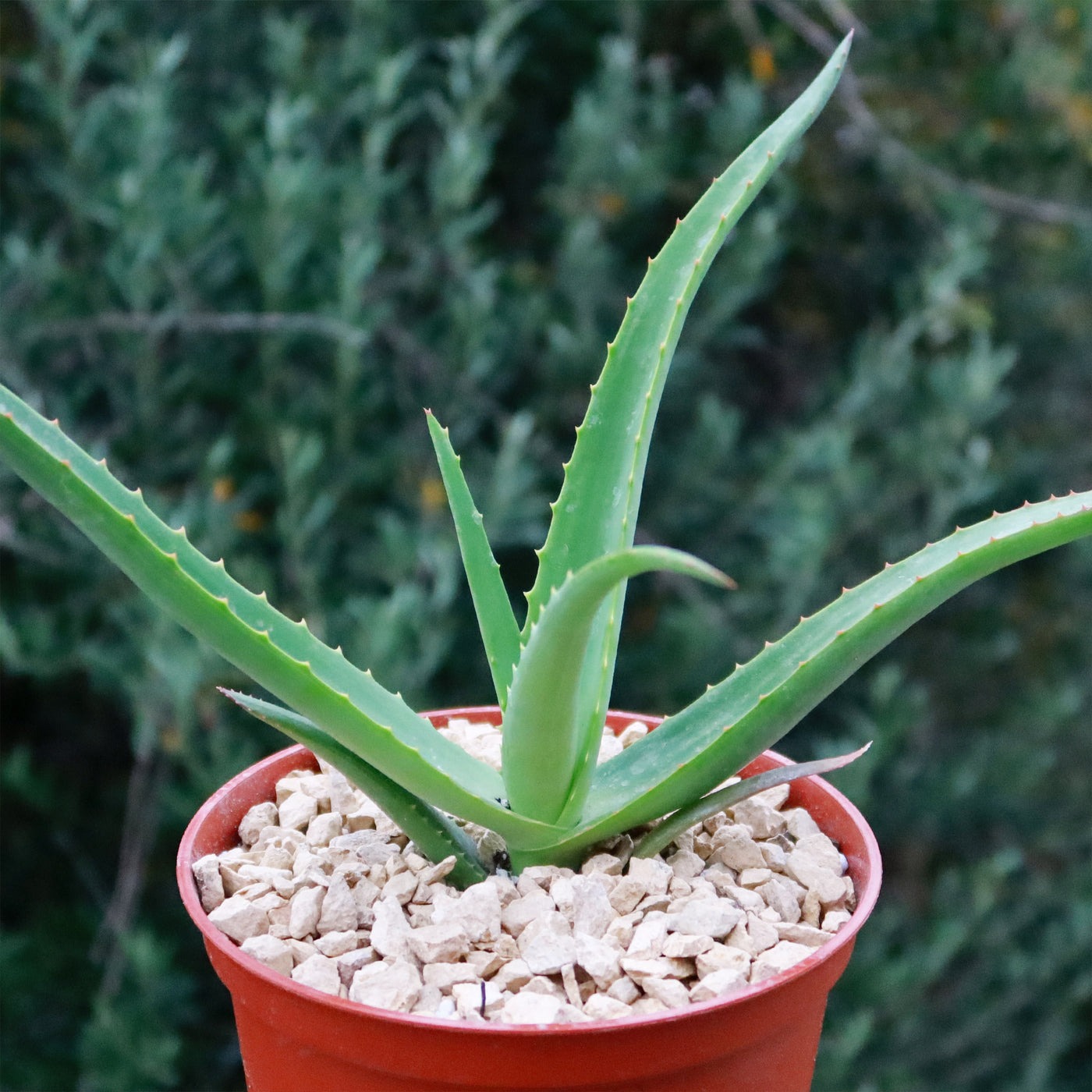
Malagasy tree aloe is a large, tree-like aloe species that can reach heights of 8-12 feet. The thick, green leaves of this aloe turn red in winter or when exposed to intense sunlight, creating a dramatic and colorful display. This plant is especially showy during the colder months, making it a striking focal point in any garden.
In addition to its vibrant foliage, Malagasy tree aloe produces tall spikes of bright red flowers that add to its winter appeal. These blooms are held high above the plant and create a stunning contrast against the red-tinted leaves. The flower spikes attract pollinators such as bees and birds, including hummingbirds.
Hardy in USDA zones 9-11, Malagasy tree aloe thrives in full sun and well-draining soil. This aloe species is perfect for gardeners looking to add height and seasonal color to their landscapes, especially in arid or Mediterranean-style gardens.
Massawana (Aloe massawana)

Massawana is a medium-sized aloe species that closely resembles the popular Aloe vera, with its tight rosette of green leaves and white markings. The leaves are adorned with small white teeth along the margins, adding texture and interest to the plant. This aloe grows to a height of 2-3 feet and can make a beautiful addition to garden beds or containers.
Massawana produces flower spikes in late winter to early spring, with torch-like clusters of red and yellow blooms that attract hummingbirds. This aloe is native to regions facing urban development, which has put pressure on its population, making it a threatened species in its native habitat.
Hardy in USDA zones 9-11, Massawana prefers full sun and well-draining soil. Its unique appearance and colorful flowers make it a standout in xeriscaped gardens or as a statement plant in rock gardens.
Mazambron (Aloe tormentorii)
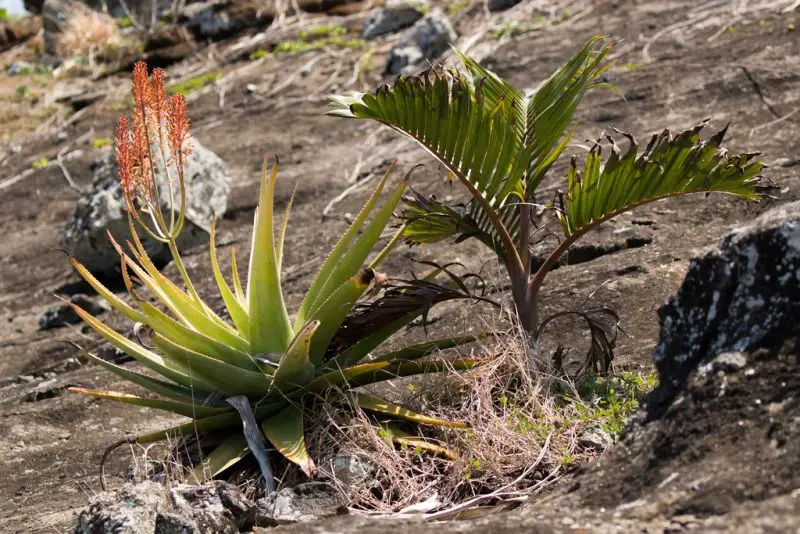
Mazambron aloe is a rare species endemic to Mauritius, making it a unique addition to any collection of aloe plants. This aloe has smooth, pointed green leaves that grow in a tight rosette formation. Under direct sunlight, the leaves can develop a slight blush, adding visual interest to the plant. Mazambron aloe typically grows to a height of 18-36 inches, making it a moderate-sized succulent.
The plant produces tall, branched flower spikes with salmon-colored blooms that fade to yellow as they mature. These flowers attract tiny geckos, which are the primary pollinators of the plant. The blooms eventually produce fruit, which serves as a main food source for an endemic species of skink on the island.
Hardy in USDA zones 9-11, Mazambron aloe thrives in well-draining soil and requires low water. Its rarity and unique pollination process make it an intriguing addition to any succulent garden, especially for those with an interest in rare or endangered plant species.
Mountain Aloe (Aloe marlothii)
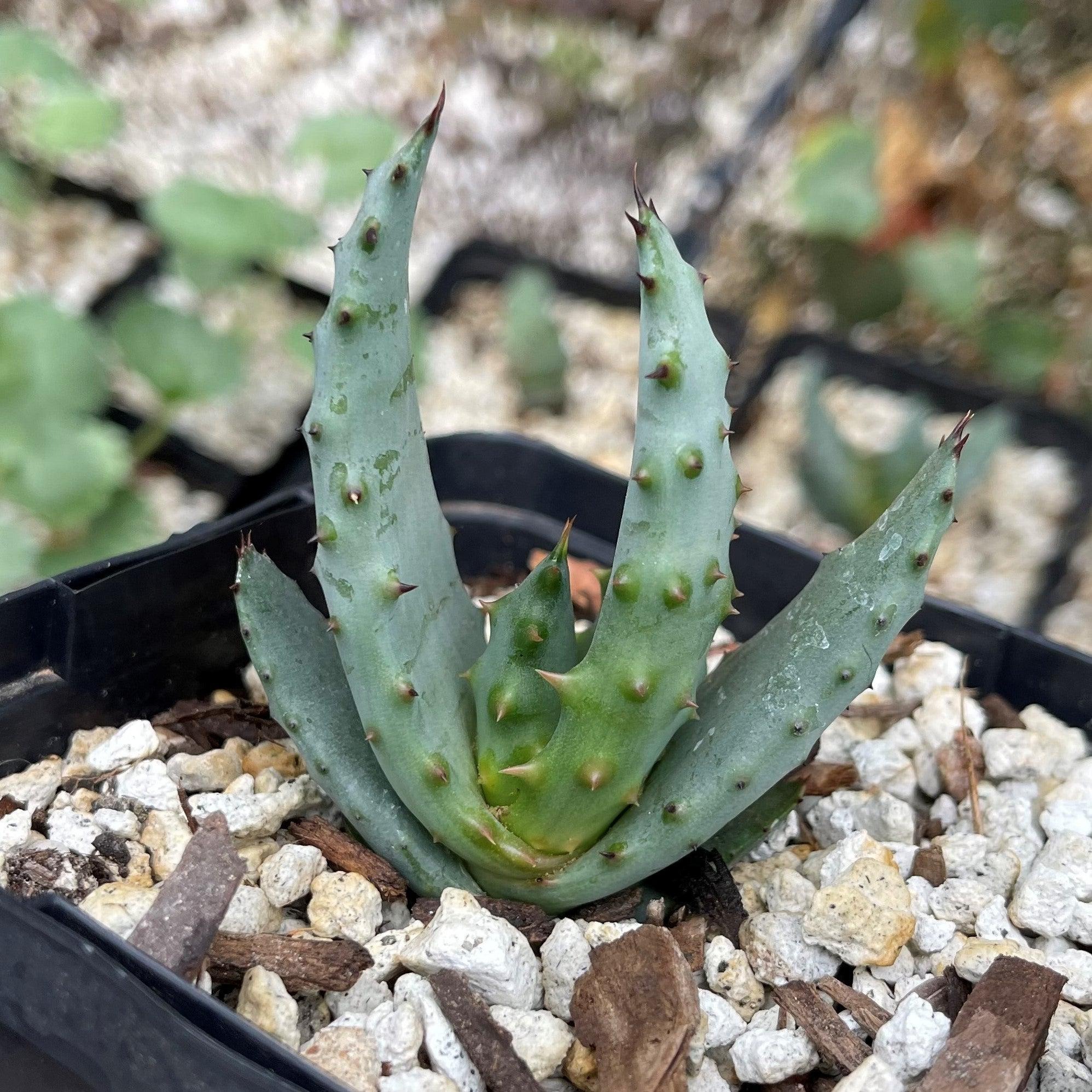
Mountain aloe is one of the largest aloe species, growing up to 10 feet tall. This striking aloe has large, gray-green leaves dotted with reddish spines, which give the plant a unique, artichoke-like appearance. As the leaves dry out, they form a skirt around the base of the plant. Mountain aloe is an excellent choice for gardeners looking for a dramatic and drought-tolerant specimen plant.
In fall and winter, mountain aloe produces multi-branched flower crowns at the top of its tall stems. These flower spikes, covered with golden-orange tubular flowers, create a breathtaking display and attract pollinators such as bees and birds. The large size and striking flower clusters make it a standout in any garden.
Hardy in USDA zones 9-12, mountain aloe thrives in full sun and well-draining soil. Its low-water requirements and stunning blooms make it an ideal plant for arid or Mediterranean-style gardens, as well as xeriscaping projects. The dramatic flower display is a showstopper, making it a valuable addition to any landscape.
Red Hot Poker (Aloe aculeata)
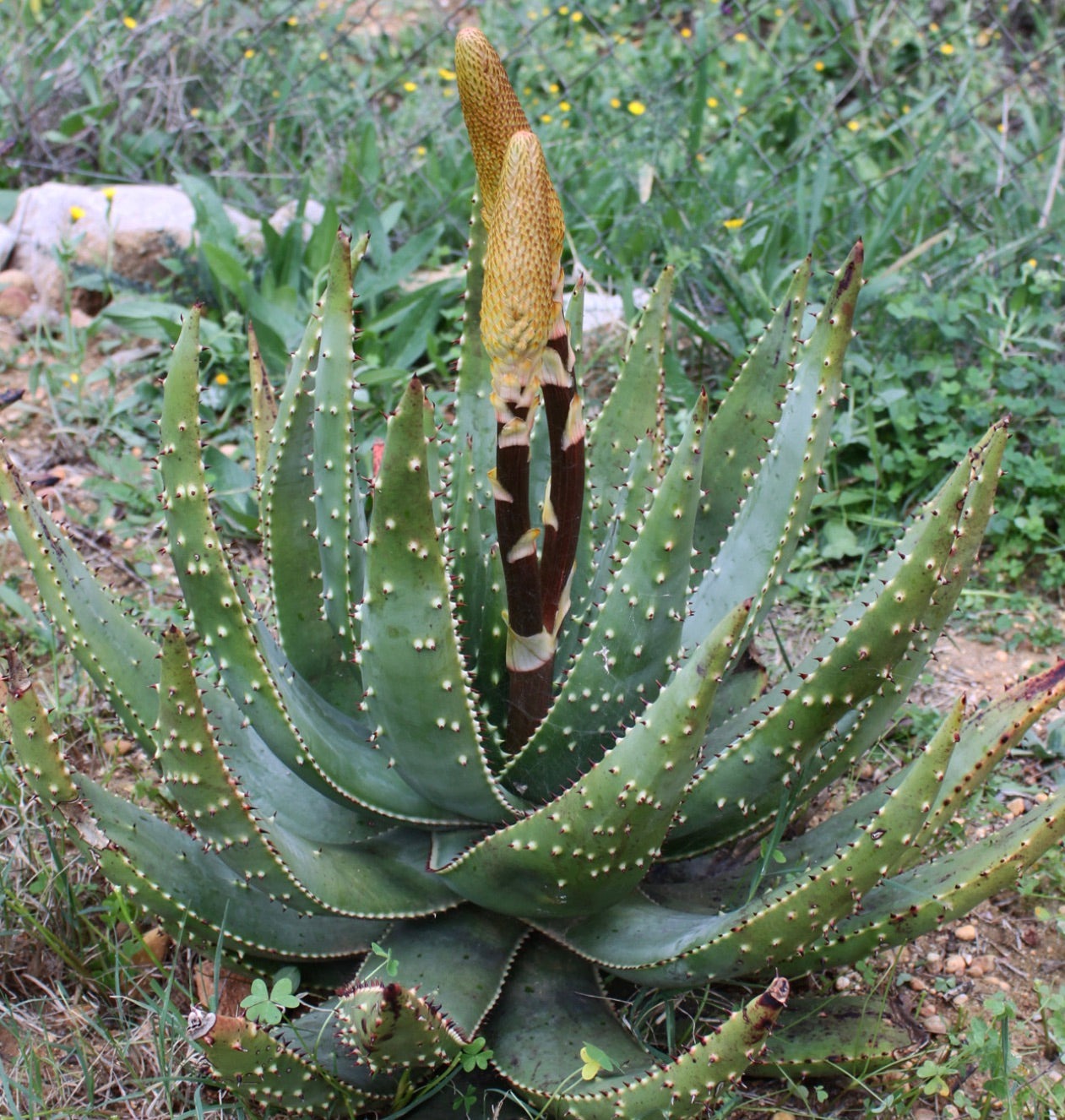
Red hot poker aloe is a dramatic plant that earns its name from the fiery, red-orange flower spikes that resemble flaming torches. The large, fleshy leaves of this species are a striking turquoise color and curve upwards, forming a large, bowl-shaped structure. This succulent grows to a height of 12-24 inches and makes a beautiful ornamental variety for gardens and landscapes.
The bright, tubular flowers of the red hot poker aloe are highly attractive to pollinators, including butterflies and hummingbirds, making it an excellent plant for wildlife-friendly gardens. The flowers bloom in late summer to early fall, creating a stunning display of color.
Hardy in USDA zones 8-10, red hot poker aloe prefers full sun and well-draining soil. With low water needs, this aloe is perfect for low-maintenance gardens, especially in areas with hot, dry climates.
White Fox (Aloe rauhii)
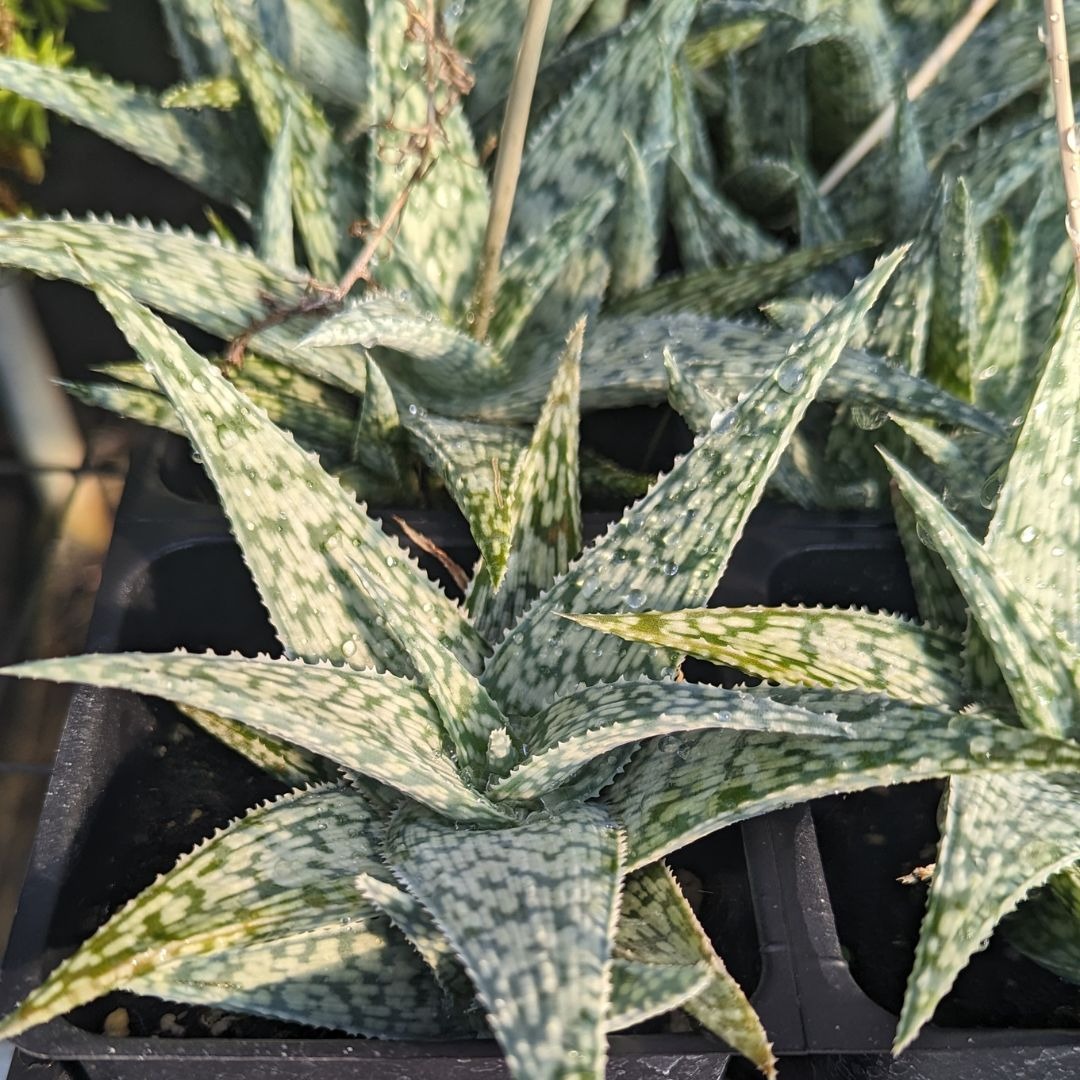
White Fox, also known as Snowflake Aloe, is a tiny, dwarf aloe species that grows to a maximum height of just 6 inches. This unique plant has green leaves that are covered with white stippling, which becomes more pronounced when exposed to plenty of light. White Fox is an ideal low-maintenance houseplant, perfect for those looking to add a bit of aloe charm to their indoor spaces.
The plant’s medicinal sap has been traditionally used to treat burns. Though it doesn’t bloom frequently, when it does, the flowers are a beautiful coral pink color, typically appearing in late spring. White Fox is a slow-growing aloe that thrives in full sun to partial shade.
This aloe is hardy in USDA zones 10-11 and requires loose, well-draining soil. It is best suited for small pots or as part of a succulent collection, adding an elegant touch to any indoor or outdoor garden.
Tiger Aloe (Gonialoe variegata)
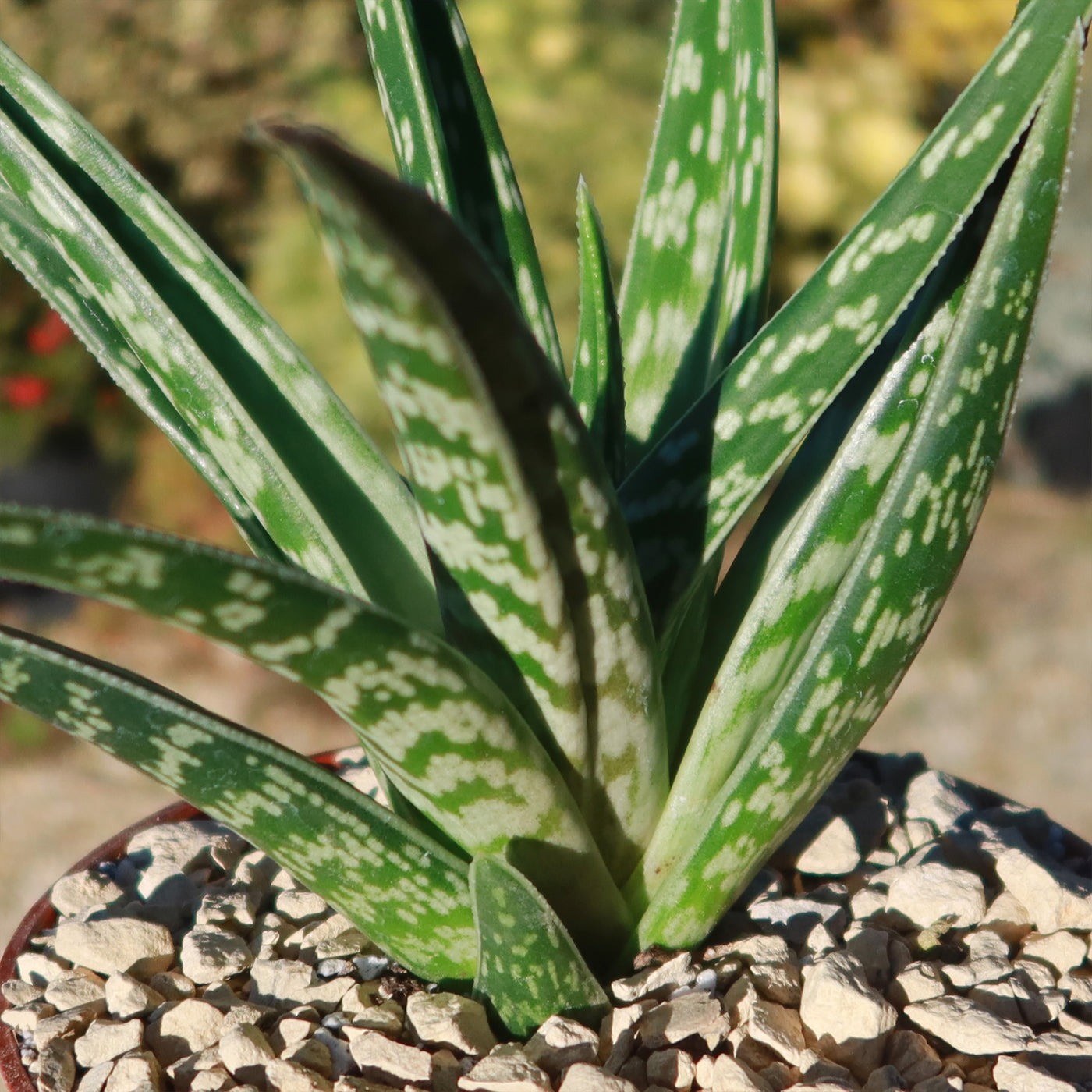
Tiger aloe, also known as partridge breast aloe, is a unique member of the Gonialoe genus, which was once considered part of the aloe family due to its similar appearance. This medium-sized plant forms a rosette of dark green leaves adorned with striking white striped patterns, resembling the stripes of a tiger.
Tiger aloe blooms with orange tubular flowers that appear on single-branched flower spikes during the summer. However, when grown as a houseplant, it is more likely to bloom in winter. The plant’s distinctive appearance and compact size make it a popular ornamental choice for small gardens and indoor spaces.
Hardy in USDA zones 9-11, tiger aloe thrives in full sun and requires well-draining soil. Its low water needs and unique look make it a great addition to succulent gardens or as a houseplant.
Tiger Tooth Aloe (Aloe juvenna)
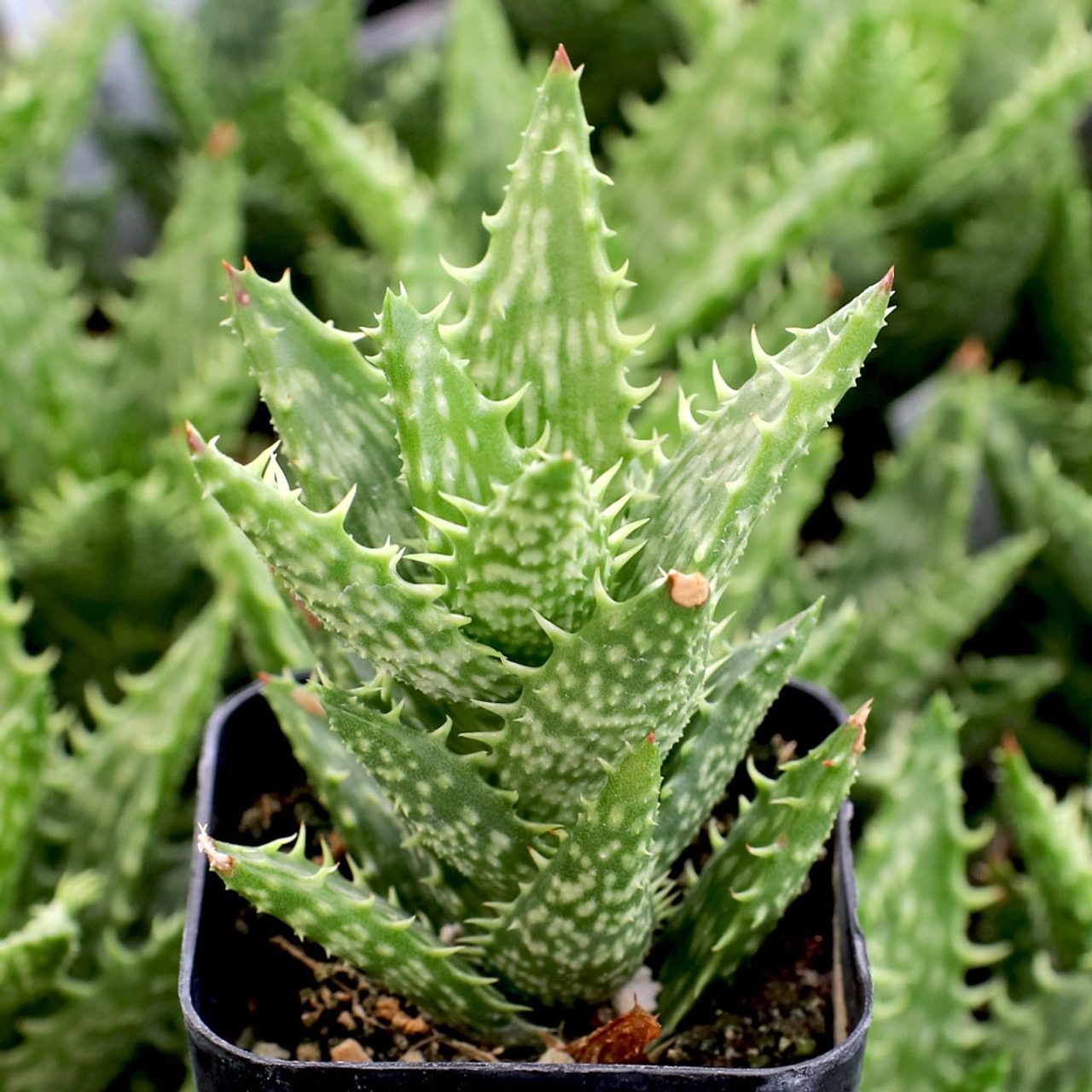
Tiger Tooth aloe, known for its striking appearance, has a clumping growth habit that produces tall, thin towers of short, plump, toothy leaves. These bright green leaves are speckled with white and develop a blush of color when exposed to full sun, giving the plant a vibrant and eye-catching look.
This aloe species is relatively low-maintenance, though it rarely blooms. When it does, the flowers are coral-pink and appear in late summer, adding a pop of color to the plant’s already attractive foliage. Tiger Tooth aloe is perfect for creating dynamic arrangements in succulent gardens or container plantings.
Hardy in USDA zones 9-11, Tiger Tooth aloe prefers full sun, well-draining soil, and has low water requirements, making it an ideal addition to arid landscapes or low-water gardens.
Tilt-Head Aloe (Aloe speciosa)
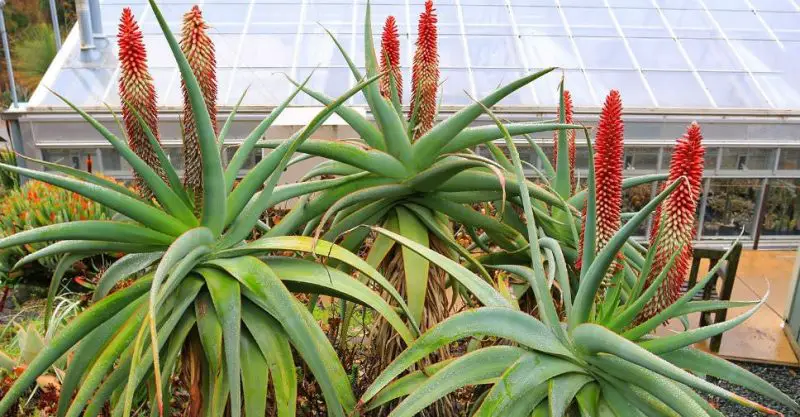
Tilt-Head aloe is an impressive species known for its large size and unique growth pattern. Reaching up to 10 feet in height, it forms a thick trunk with a large rosette of long, convex leaves that tilt to one side, making it an eye-catching plant. The silvery-green leaves contrast beautifully with the bright red stamens of the flowers, creating a vibrant spectacle in gardens.
This aloe blooms in spring with 2-foot flower spikes, each covered in buds that eventually open into green and white striped flowers. The plant is hardy to 20°F (-7°C), making it suitable for USDA zones 9-10. It thrives in full sun and well-draining soil, requiring minimal water, and is particularly attractive to hummingbirds due to its colorful, fragrant blooms.
Tilt-Head aloe is perfect for gardeners looking for a striking and cold-hardy succulent that adds height and texture to any landscape.
Tree Aloe (Aloe barberae)
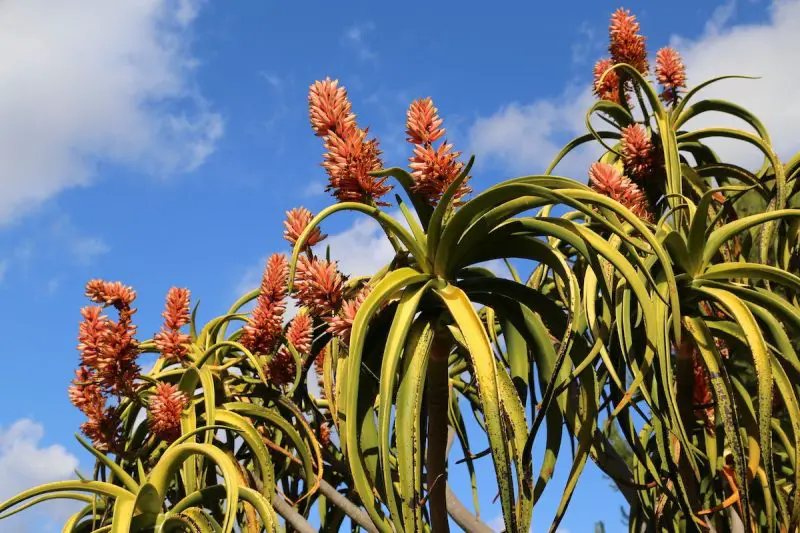
Tree aloe is one of the largest aloes, capable of reaching heights of 30 feet. This tree-like aloe has a central trunk and gracefully sloping, gray-barked branches, each holding a convex rosette of long, narrow green leaves. Its size and sculptural form make it a standout plant in larger gardens or as a focal point in xeriscapes.
In winter, the tree aloe produces short flower spikes with cone-shaped inflorescences. These spikes start as pink buds, opening to reveal bright orange flowers, which add a splash of color to the garden. Tree aloe is well-suited for USDA zones 9-11 and thrives in full sun and well-draining soil, with low water requirements.
This towering aloe is an excellent choice for those seeking a dramatic, ornamental plant that thrives in warm climates and attracts birds and pollinators.
Van Balen’s Aloe (Aloe vanbalenii)
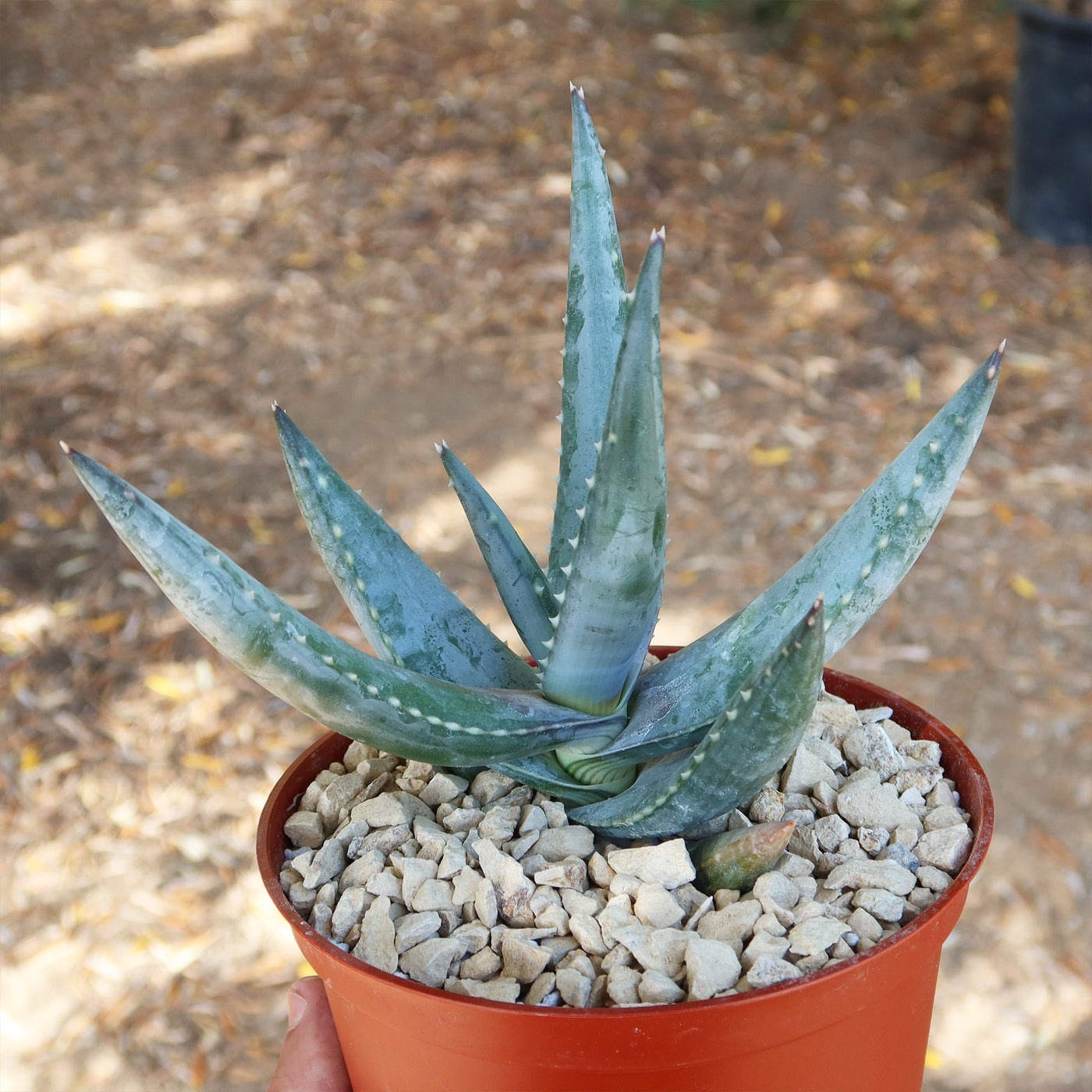
Van Balen’s Aloe is a striking, low-maintenance succulent that resembles an octopus with its deeply channeled, outward-curving leaves. The bright yellow-green leaves have a tendency to blush at the tips when exposed to full sun, creating a stunning visual effect. This aloe species typically grows to a height of 12-24 inches, making it a perfect choice for smaller gardens or container plantings.
In early spring, unbranched flower spikes emerge, producing clusters of yellow to orange flowers that attract a variety of pollinators, including birds and bees. Van Balen’s Aloe thrives in USDA zones 9-11, requiring full to partial sun and well-draining soil. It is drought-tolerant and easy to grow, making it ideal for low-maintenance landscapes.
This aloe variety is perfect for adding texture and color to gardens while supporting local wildlife.
Rubble Aloe (Aloe perfoliata)
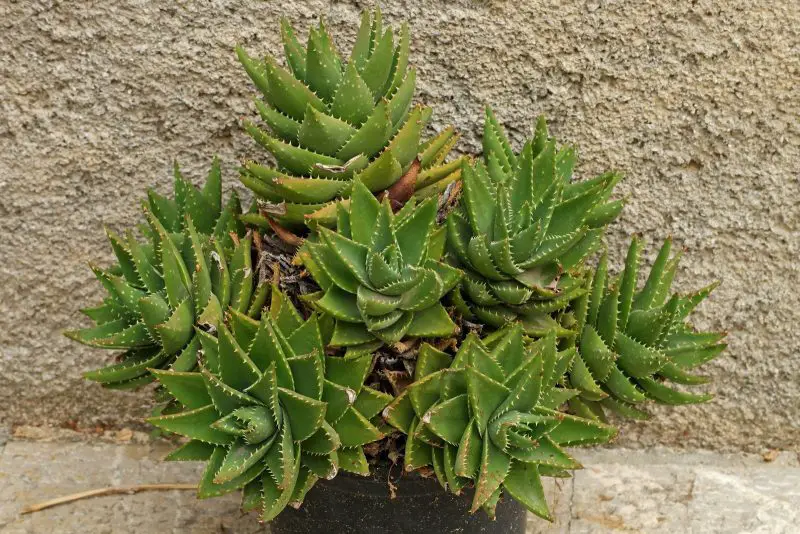
Rubble aloe is a distinctive species known for its creeping habit, which makes it perfect for groundcover or container planting. This aloe spreads along the ground, with only the leaf-bearing heads standing upright, facing the sun. The plant grows up to 6 feet in height and is best contained in a pot to prevent it from overtaking the garden.
Unlike most aloes, rubble aloe blooms in the summer, producing bright red, pom-pom-like clusters of tubular flowers atop long, branching flower spikes. The flowers attract hummingbirds and bees, making it an excellent addition to pollinator-friendly gardens.
Rubble aloe thrives in full sun and well-draining soil and is hardy in USDA zones 9-10. With its low water needs and creeping nature, it is an ideal plant for rock gardens or xeriscaping projects, where it can spread and cascade over the landscape.
Sand Aloe (Aloe hereroensis)
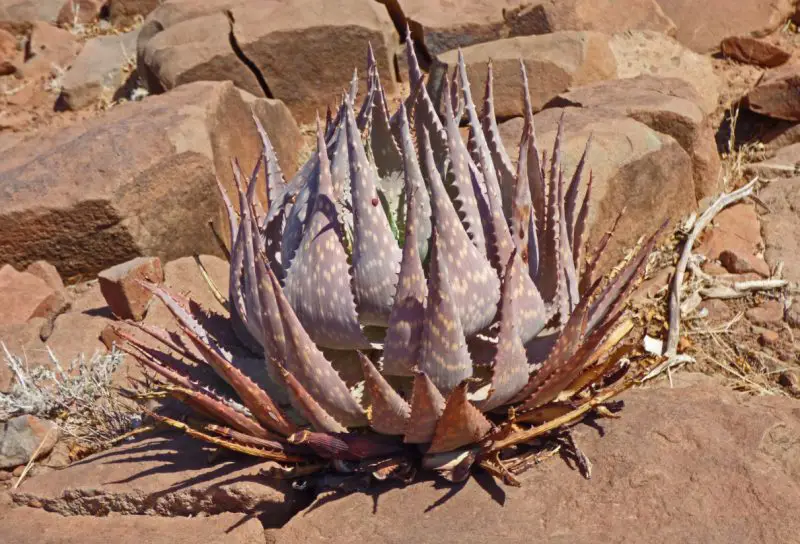
Sand aloe is a medium to large-sized succulent native to rocky, sandy terrains. This plant grows 12-24 inches tall, with long, tapering leaves that form a loose rosette and curve upwards. The leaves range in color from pale green to bronze, depending on sunlight exposure and climate conditions.
One of the most remarkable features of sand aloe is its winter flowering habit. The plant produces a tall, branched inflorescence with each branch topped by a ball-shaped cluster of large, red tubular flowers. These vibrant blooms create a stunning winter display and attract pollinators, such as hummingbirds.
Hardy in USDA zones 9-11, sand aloe requires full sun and well-draining soil. With its low water needs and dramatic winter bloom, it is an excellent choice for gardeners looking to add color and interest to their landscapes during the colder months.
Short-Leaf Aloe (Aloe brevifolia)
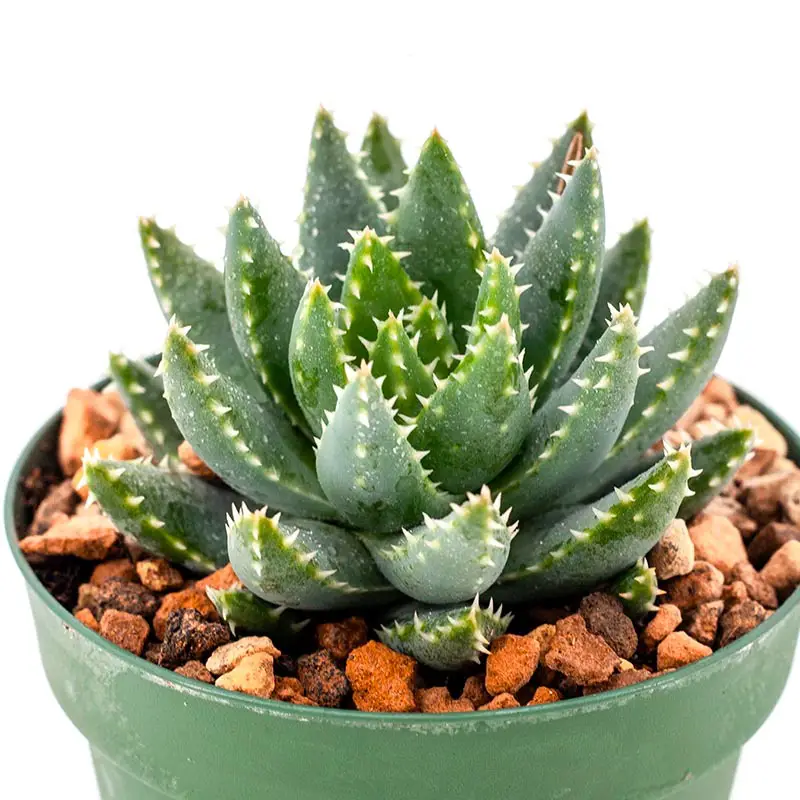
Short-leaf aloe is a striking succulent known for its compact, tightly-formed rosettes of short, triangular-shaped leaves. The leaves are initially pale blue when grown in light shade, but exposure to full sun causes the tips and edges to turn shades of yellow and coral, creating a vibrant contrast with the blue center.
The plant’s leaves are lined with white, tooth-like edges, adding texture and visual interest. As the plant matures, it forms a mound of rosettes that grow to about 12-24 inches in height. This clumping aloe produces coral-colored tubular flowers in the spring, which further enhance its attractiveness.
Ideal for full sun and well-draining soil, short-leaf aloe is hardy in USDA zones 8-11. With low water requirements, it’s a great addition to rock gardens, container plantings, or low-maintenance landscapes.
Snake Aloe (Aloe broomii)
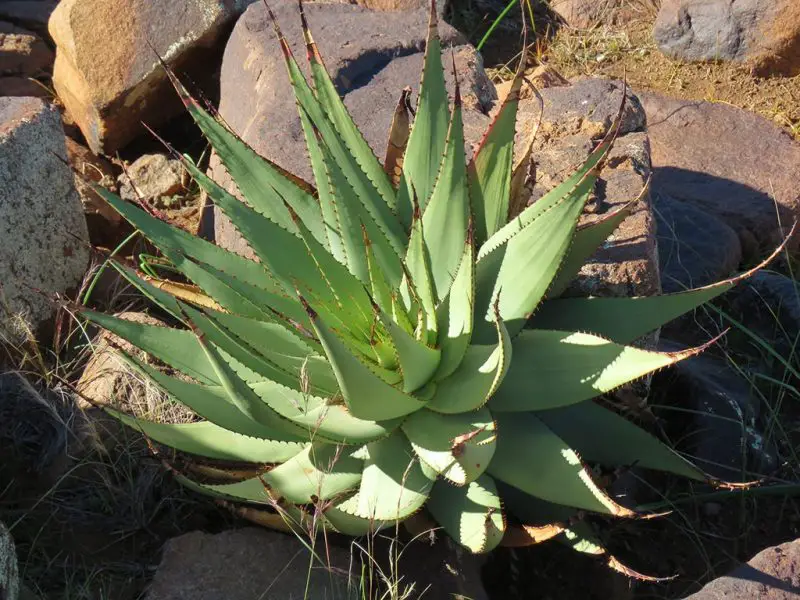
Snake aloe is a visually appealing succulent that features bright green leaves arranged in a neat rosette, edged with deep red, curved teeth. The leaves’ unique shape and color make this species a standout in any garden or container. The plant’s name is derived from the snake-like appearance of the red, bract-covered flower spikes.
Growing up to 3-4 feet tall, snake aloe is frost-resistant and well-suited to arid and semi-arid regions. It typically grows as a solitary plant but occasionally produces offsets. Its yellow-orange flowers, though hidden by the extended bracts, are still an interesting feature.
Snake aloe thrives in full sun and well-draining soil. Hardy in USDA zones 9-11, it has low water requirements and is a fantastic addition to dry gardens, xeriscapes, or ornamental landscapes.
Soap Aloe (Aloe maculata)
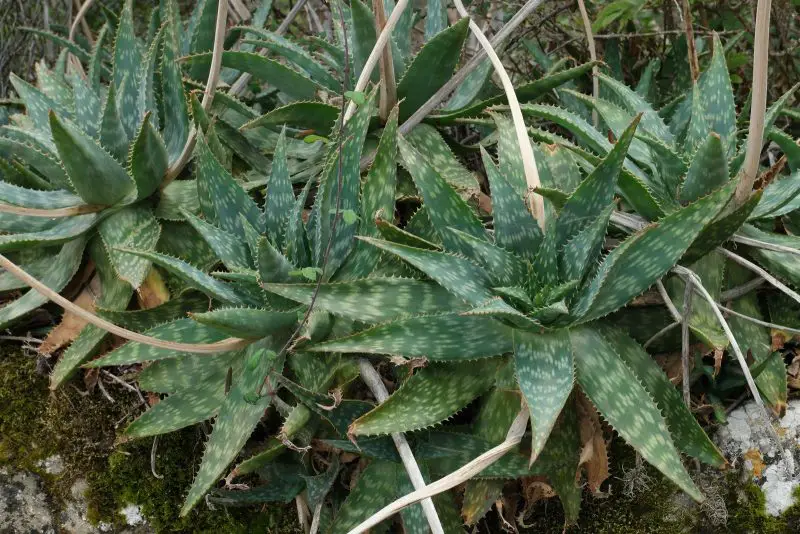
Soap aloe is a beautiful, low-growing succulent that thrives in full sun, though it can also tolerate some shade. The leaves of this species are thick, spotted with white markings, and can take on a pinkish hue when exposed to full sun, making it an attractive choice for a variety of landscapes.
In spring, soap aloe produces tall, branched flower spikes that can grow up to 3 feet high. These spikes are topped with bright red tubular flowers that bloom from late winter to the end of spring, attracting hummingbirds and other pollinators. The plant’s flowers make it a valuable addition to gardens looking to attract wildlife.
Soap aloe is well-suited for USDA zones 8-12 and prefers well-draining soil. With its low water needs and striking flowers, it’s perfect for low-maintenance gardens, container plantings, or xeriscapes.
Spider Aloe (Aloe humilis)
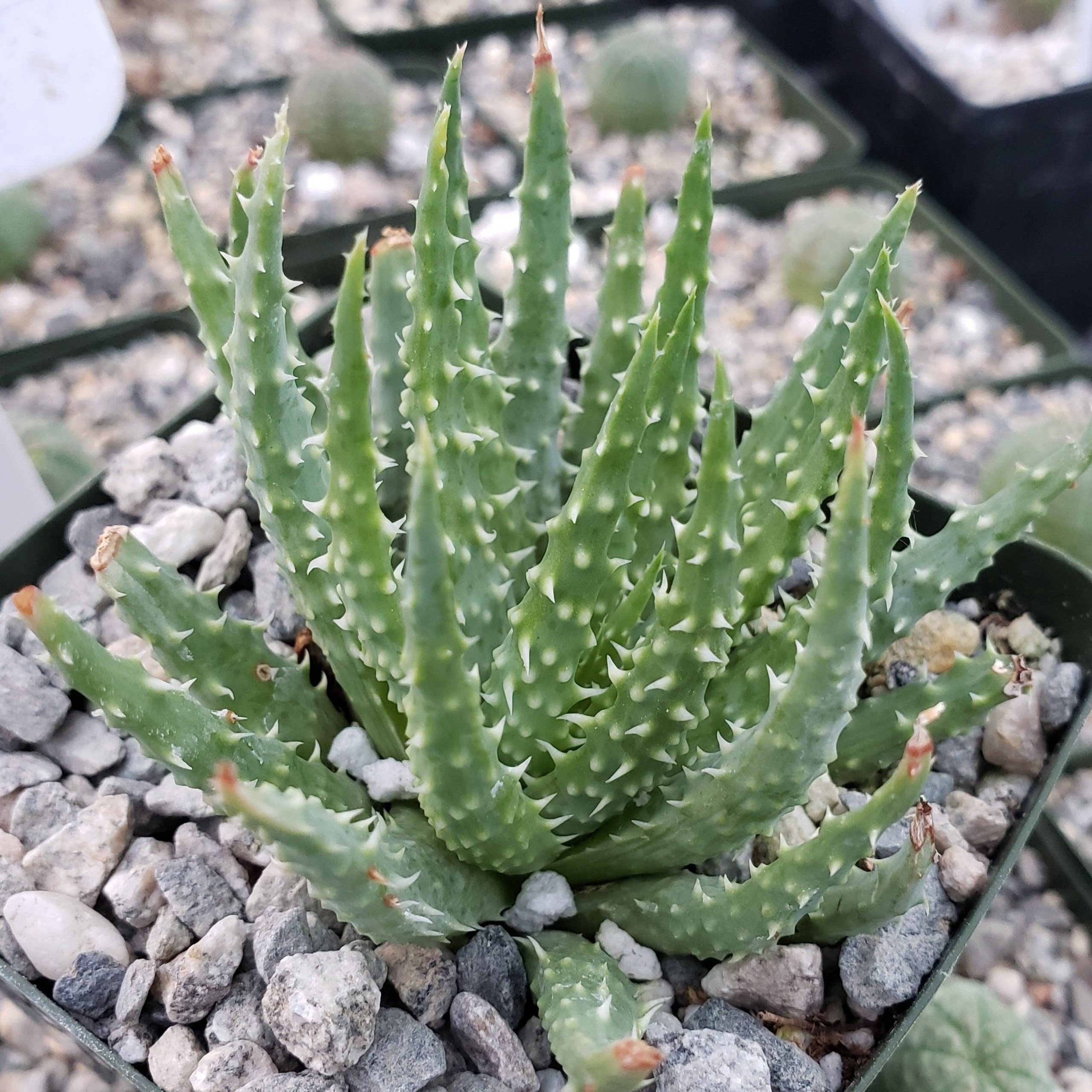
Spider aloe is a dwarf aloe species that reaches a height of just 12-20 inches, making it ideal for small spaces or indoor plantings. The plant forms a starburst-like shape from above, with slender, blue-green leaves that are speckled with white. The compact size and unique leaf arrangement make it a favorite for small gardens or containers.
This aloe produces multiple flower spikes, each topped with bright red-orange tubular flowers. The flowers add a pop of color to the plant, which is also known for its low-maintenance care. Spider aloe is a great choice for gardeners looking for a small, eye-catching succulent that thrives with minimal attention.
Spider aloe does best in full sun to part shade and prefers well-draining soil. It is hardy in USDA zones 9-11 and has low water requirements, making it perfect for those seeking a hardy and attractive succulent for dry landscapes or indoor displays.
Spiral Aloe (Aloe polyphylla)
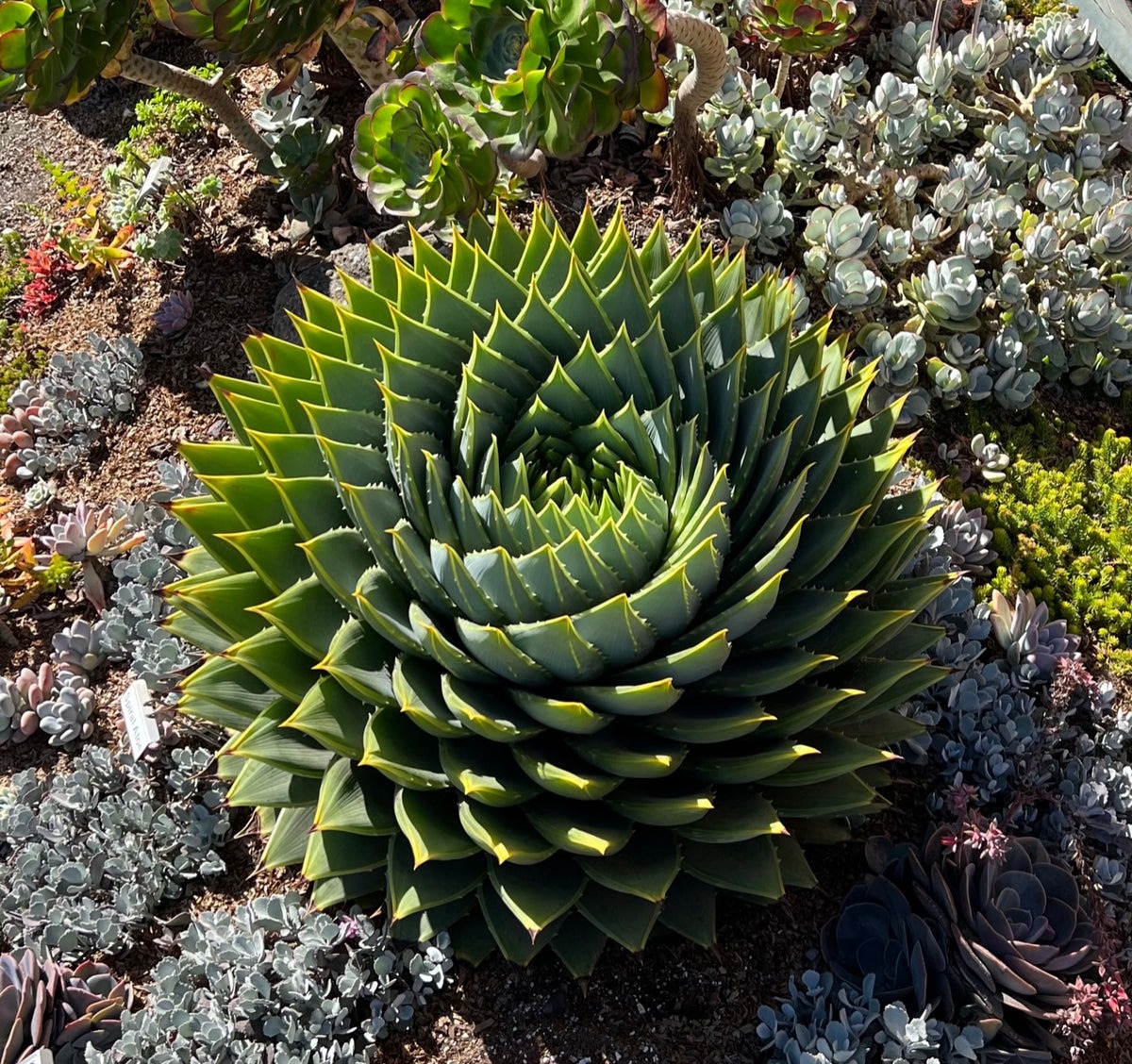
Spiral aloe is one of the most fascinating and visually captivating aloe species. Its thick, blue-green leaves grow in a tight, organized spiral formation, which can run either clockwise or counterclockwise. The plant’s striking symmetry and unique leaf arrangement make it a true ornamental gem.
Growing to about 10-12 inches tall, spiral aloe produces a branching flower spike in spring, topped with pink and orange tubular flowers. The flowers add a colorful touch to this already eye-catching plant, which is in high demand due to its rarity and ornamental value.
Spiral aloe thrives in full sun and well-draining soil. Hardy in USDA zones 9-10, it has low water requirements and is perfect for collectors or anyone looking to add a unique succulent to their garden or indoor plant collection.
Stone Aloe (Aloe petricola)
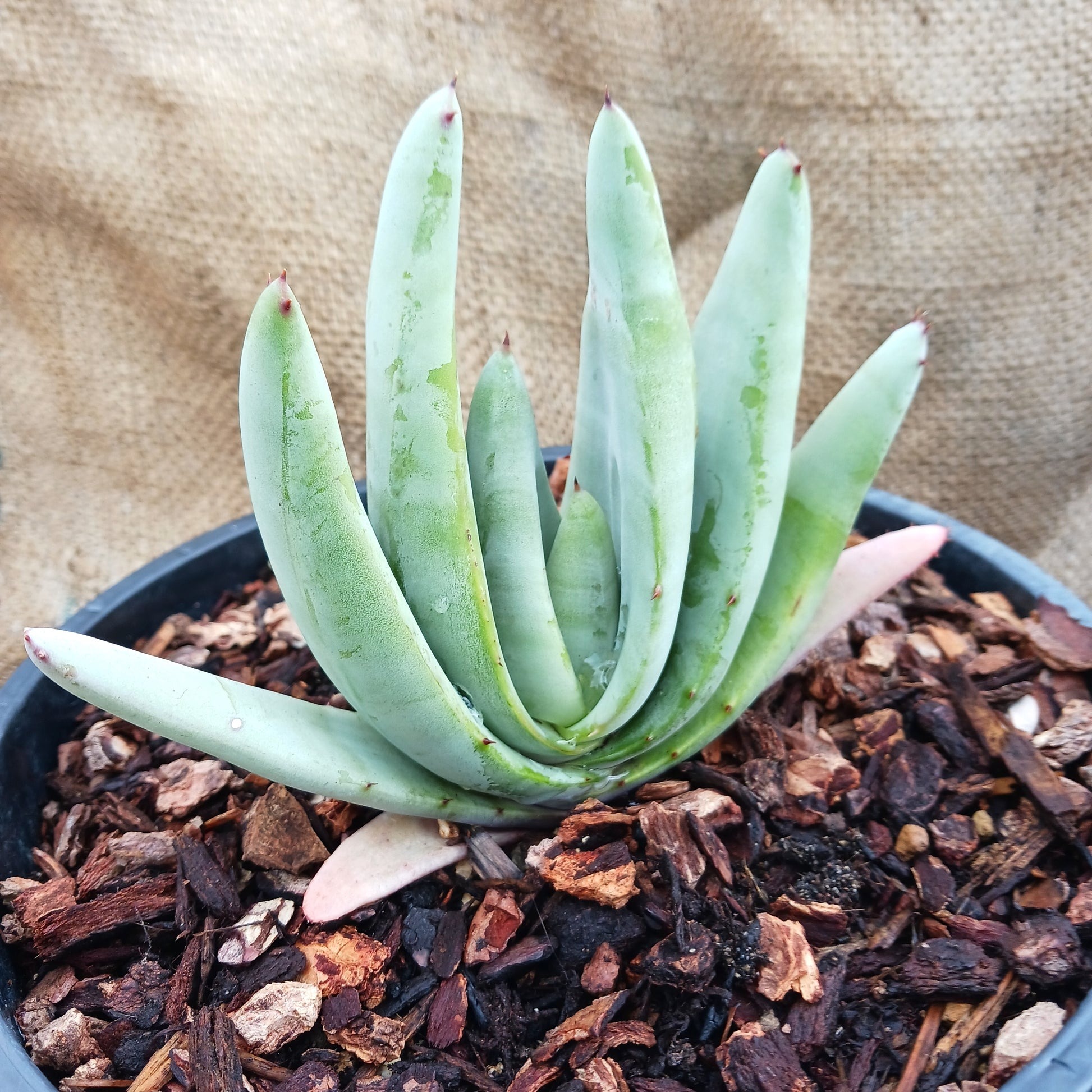
Stone aloe is an evergreen succulent that is ideal for rocky areas or gardens. Known for its slow-growing and slow-spreading nature, it forms a unique bowl-shaped growth habit that is well-suited for succulent gardens or xeriscaping. The long, pointed leaves are grayish-green, and their tips develop a subtle blush when exposed to sunlight.
This aloe species is relatively low-maintenance and can thrive in full sun with well-draining soil. In the summer, it produces multiple flower spikes, beginning as bright yellow to red buds that gradually open into pale yellow to green flowers. These blooms add beauty to the plant and are followed by fruiting when the flowers drop. Stone aloe is also valued in cosmetic and medicinal preparations.
Stone aloe is hardy in USDA zones 9-11 and requires minimal watering, making it a perfect addition to water-efficient landscapes or low-maintenance gardens.
Sunset Aloe (Aloe dorotheae)
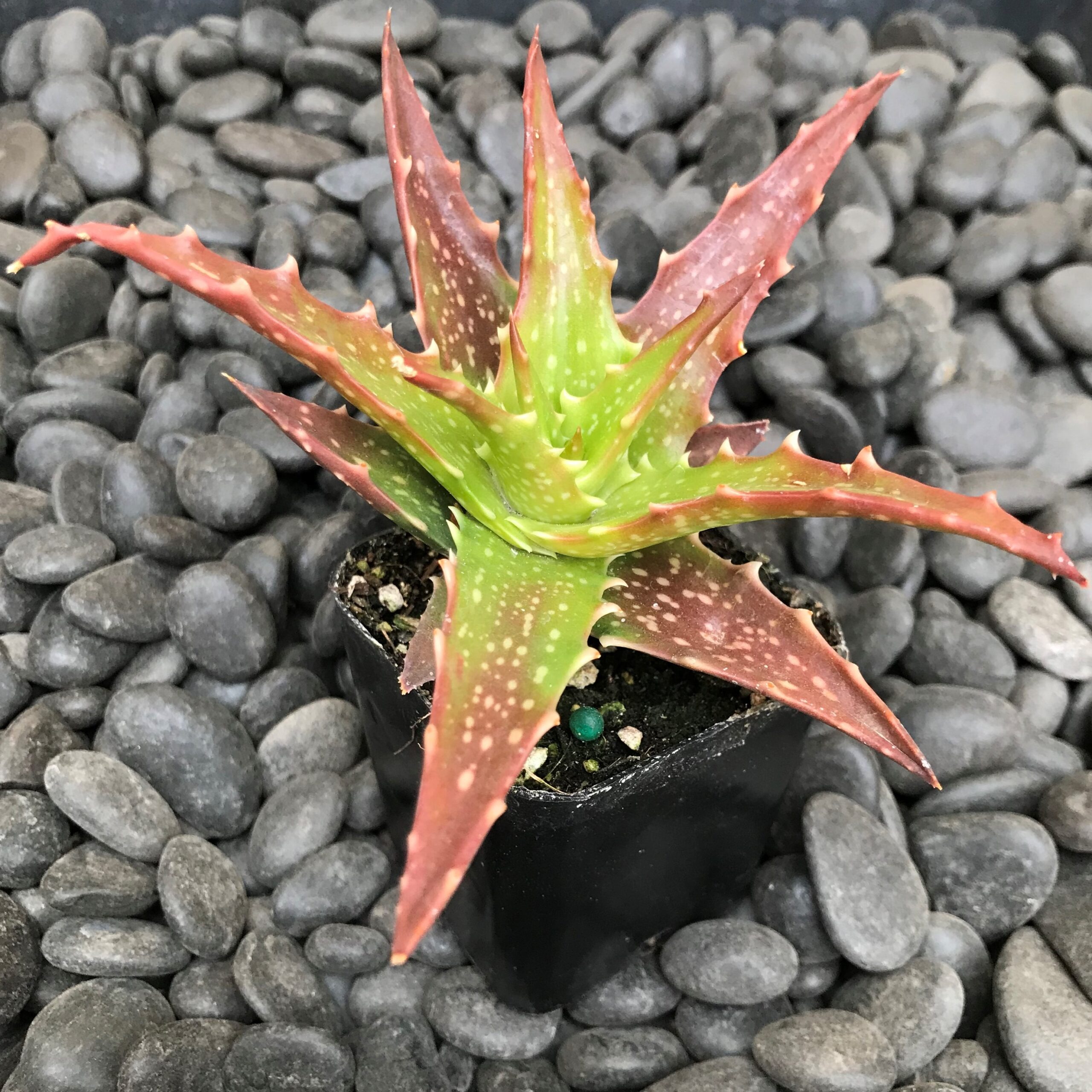
Sunset aloe is named for the bright red and orange hues that appear on its leaves when exposed to full sunlight. This aloe is a small, compact plant, growing to a height of 10-12 inches. Its shiny, curved leaves are bright yellowish-green in partial shade, but when placed in full sun, they transform into a vibrant ombre of green, gold, and red.
Sunset aloe quickly forms offsets and creates a cheerful, colorful colony. It blooms in the winter, sending up single, unbranched flower spikes topped with salmon-colored flowers that fade to yellowish green at the tips. The plant’s low-maintenance care and striking appearance make it an excellent choice for sunny areas.
Hardy in USDA zones 10-11, sunset aloe thrives in loose, well-draining soil and requires little water, making it a great addition to low-water landscapes or container plantings.






